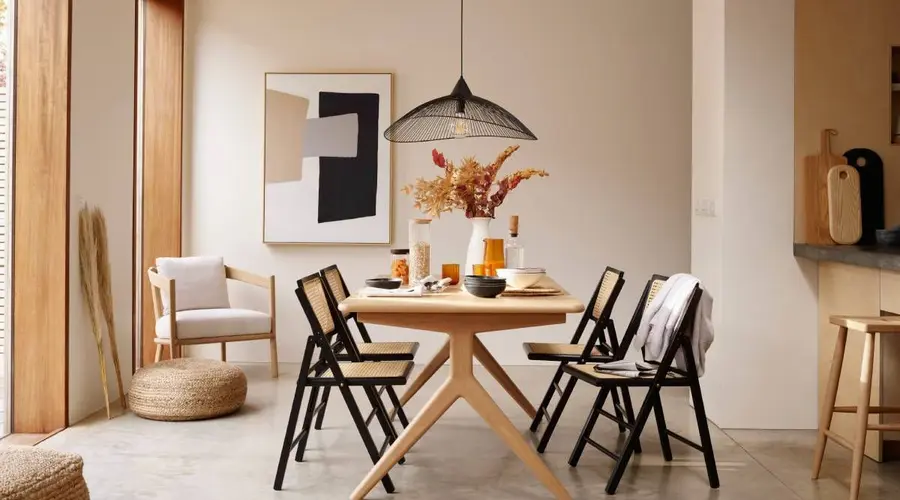Embark on a delightful journey where Japanese grace meets Scandinavian charm in your dining room. We will explore 51 unique Japandi dining room ideas that exude elegance and simplicity.
Explore the dance of materials and the poetry of space to redefine your dining experience.
Join us in the art of Japandi-style harmony—a tale where every nuance whispers the beauty of cultural synthesis. Ready to transform your space?
Let’s dive in!
Japandi Dining Room Ideas
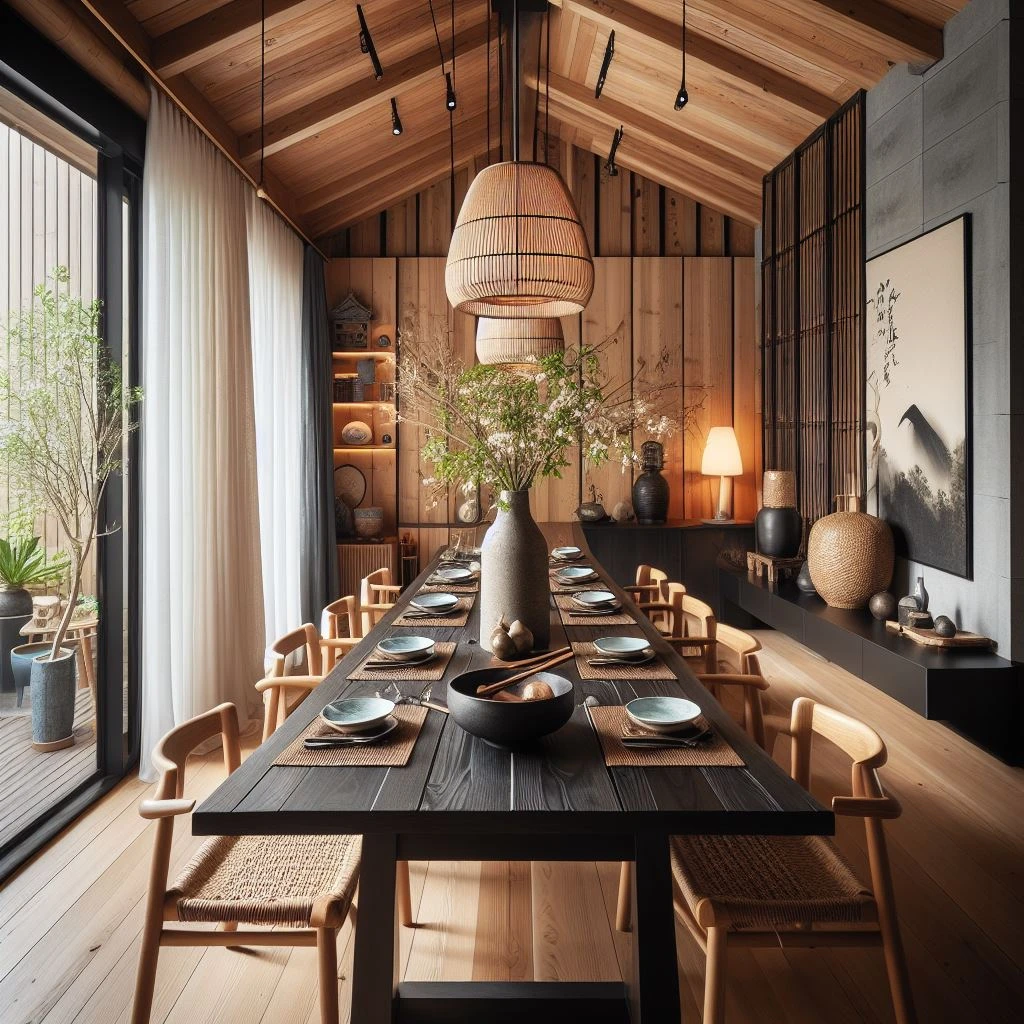
1. Fusion of Materials
Combine traditional Japanese materials like shou sugi ban (charred wood) with Scandinavian light woods to create a unique contrast in furniture.
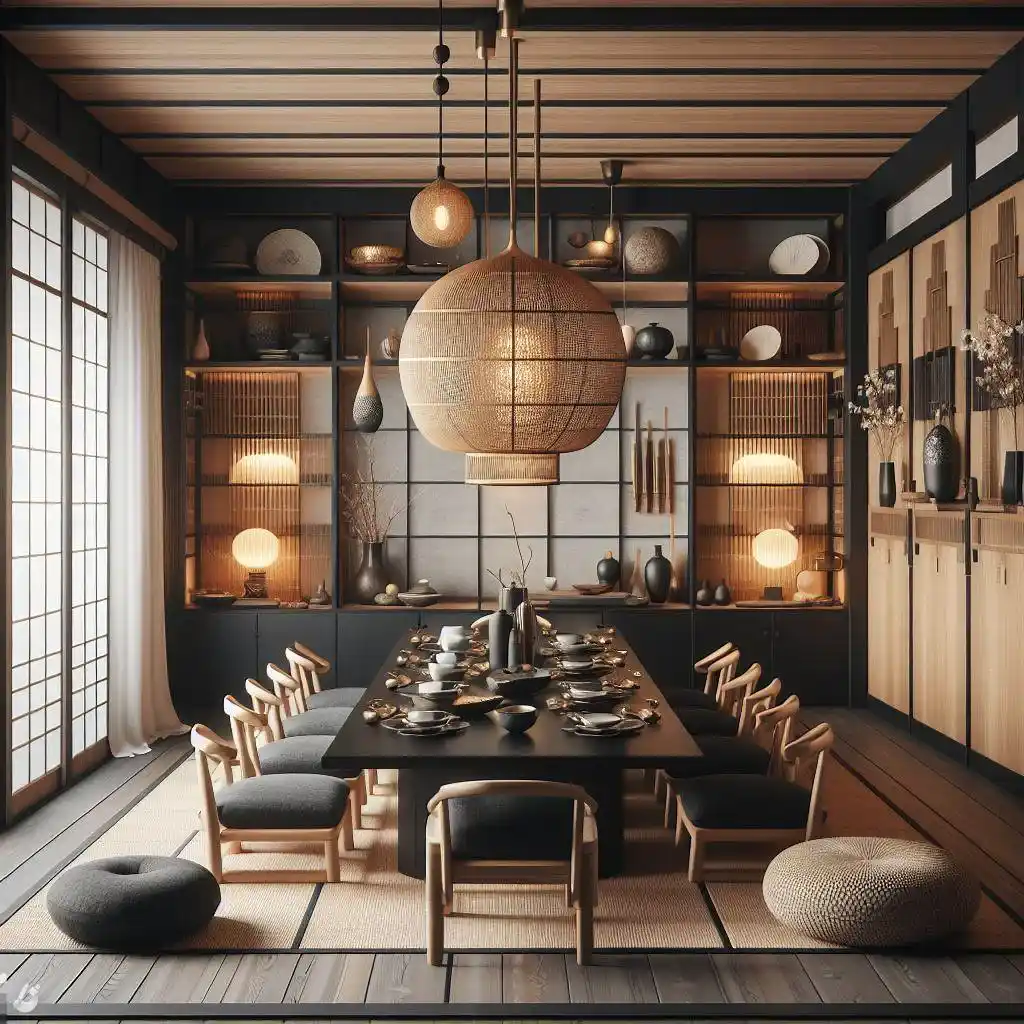
2. Asymmetrical Seating
Mix traditional Japanese floor seating with modern Scandinavian chairs, creating an eclectic and comfortable dining experience.
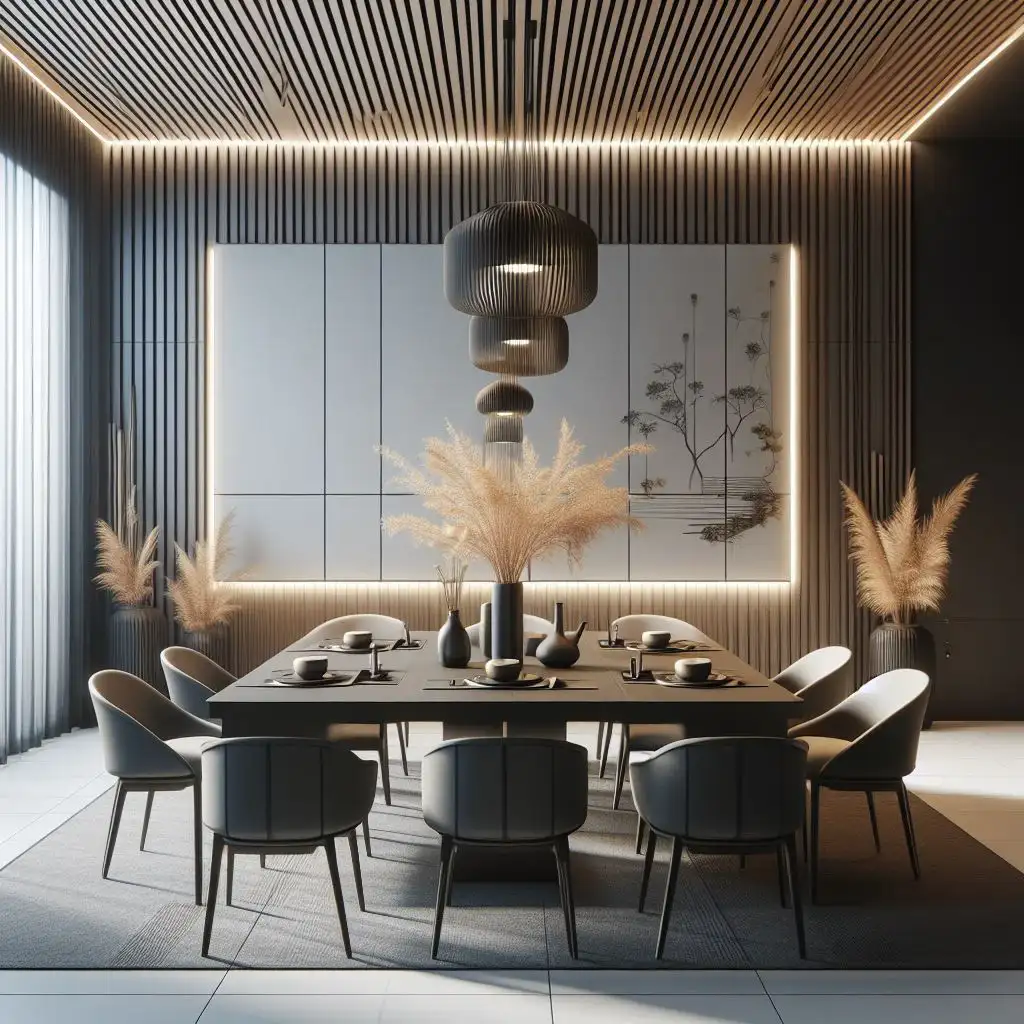
3. Futuristic Minimalism
Integrate modern, sleek furniture designs with minimalistic Japanese aesthetics for a futuristic Japandi look.
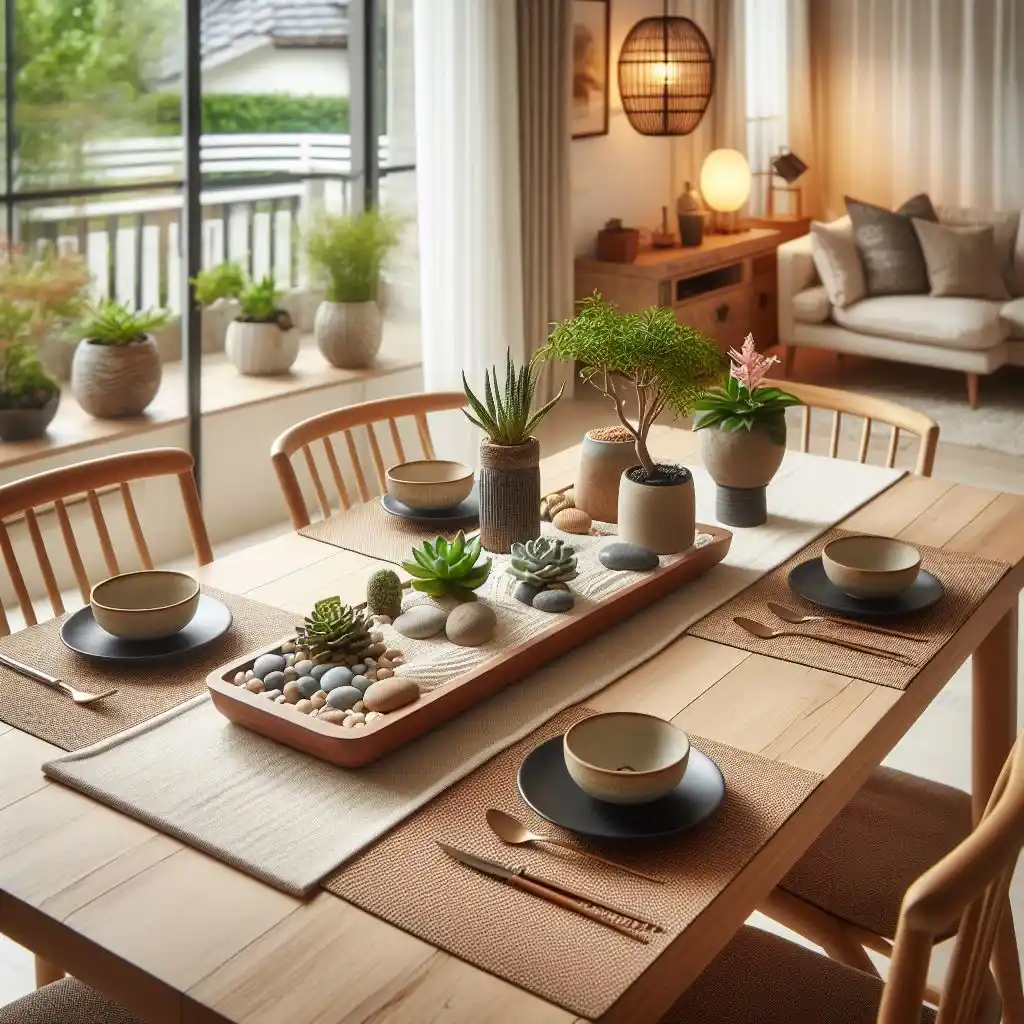
4. Zen Garden Centerpiece
Design a miniature zen garden as a centerpiece on the dining table, incorporating rocks, sand, and small succulents.
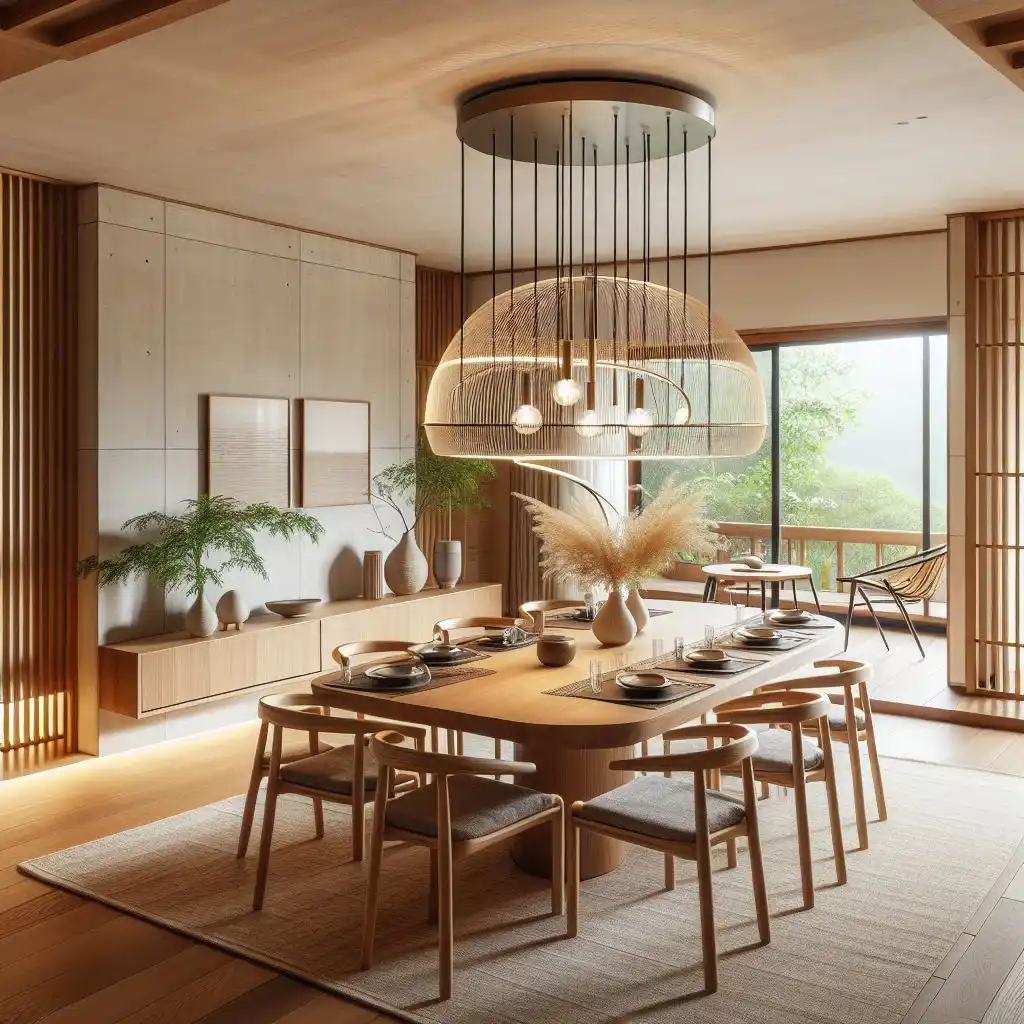
5. Mobile Pendant Lights
Hang mobile pendant lights above the dining table, inspired by traditional Japanese wind chimes and Scandinavian simplicity.
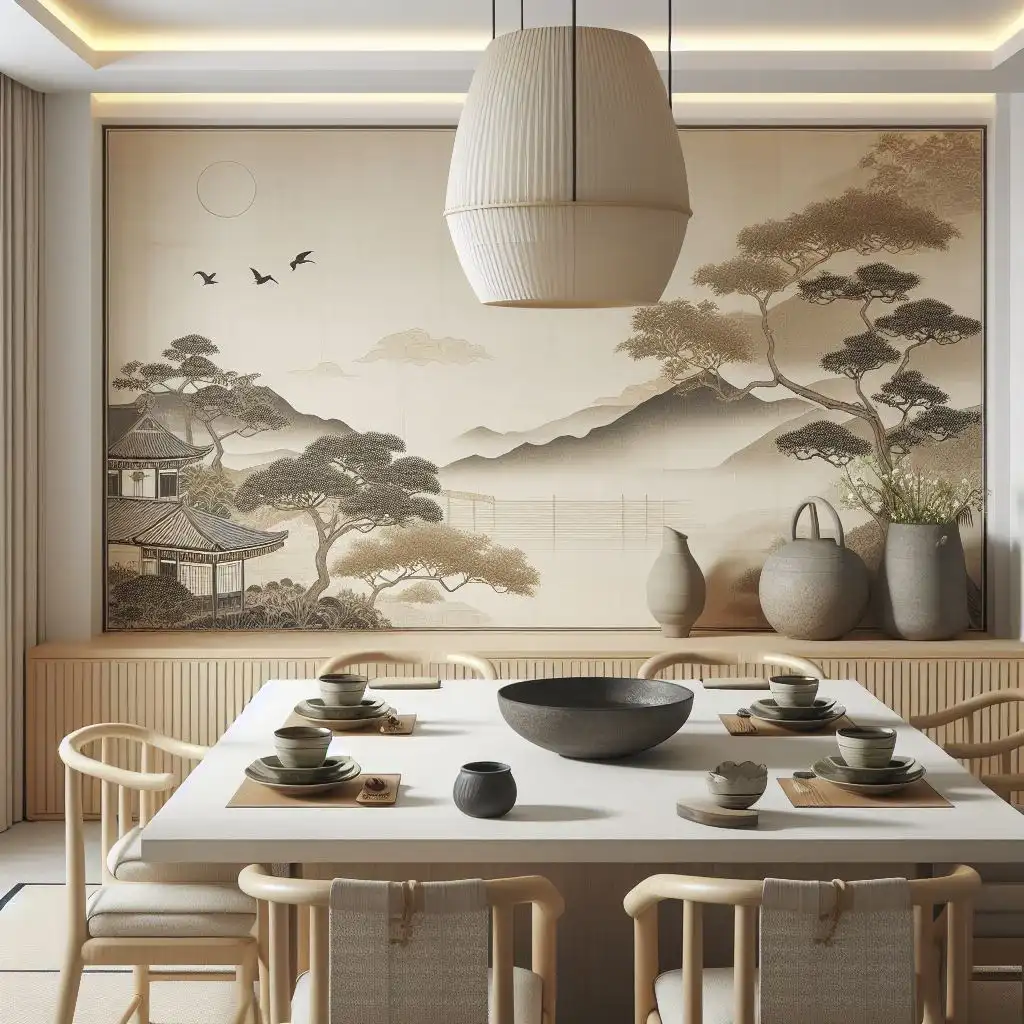
6. Ceramic Wall Mural
Create a ceramic mural on one dining room wall, depicting a serene Japanese landscape or simple geometric patterns.
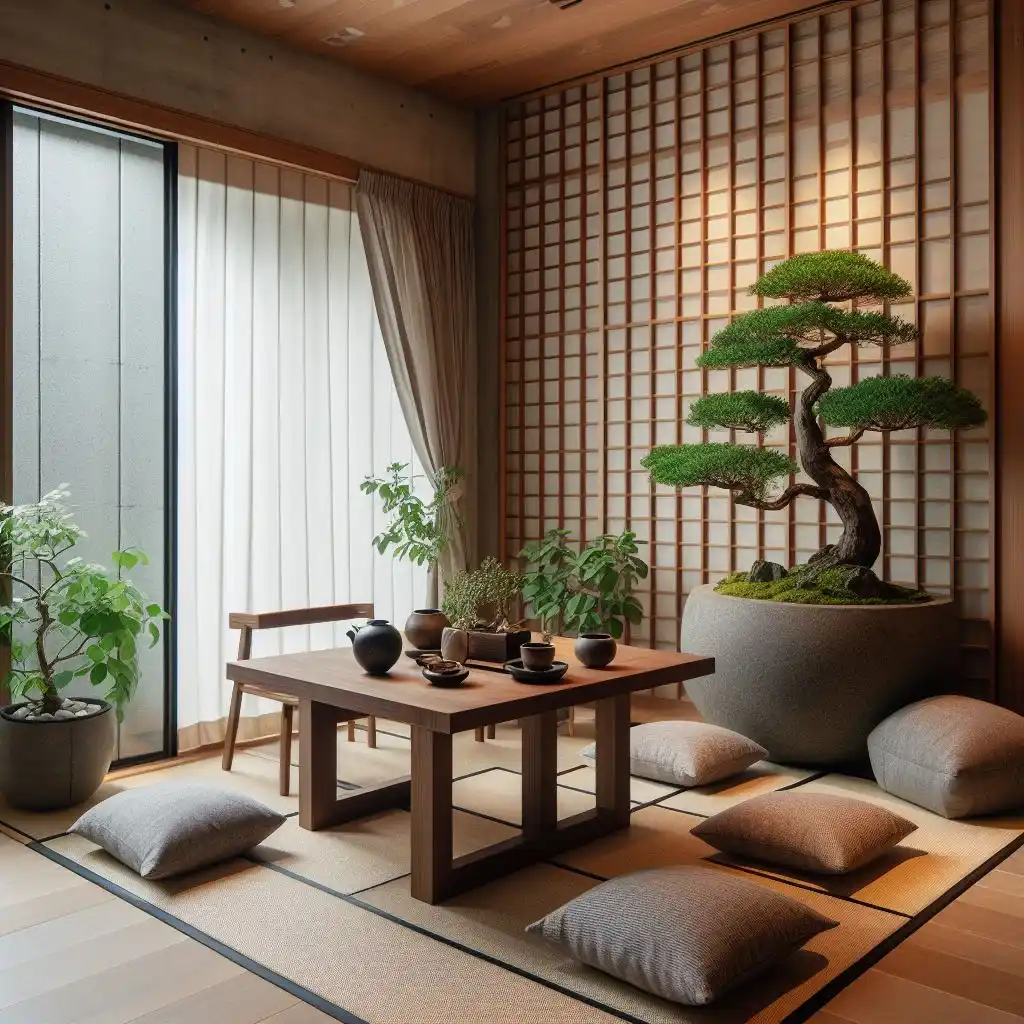
7. Japandi Corner
Designate a small corner with a low table, floor cushions, and a bonsai tree, evoking a tranquil Japanese tea ceremony atmosphere.
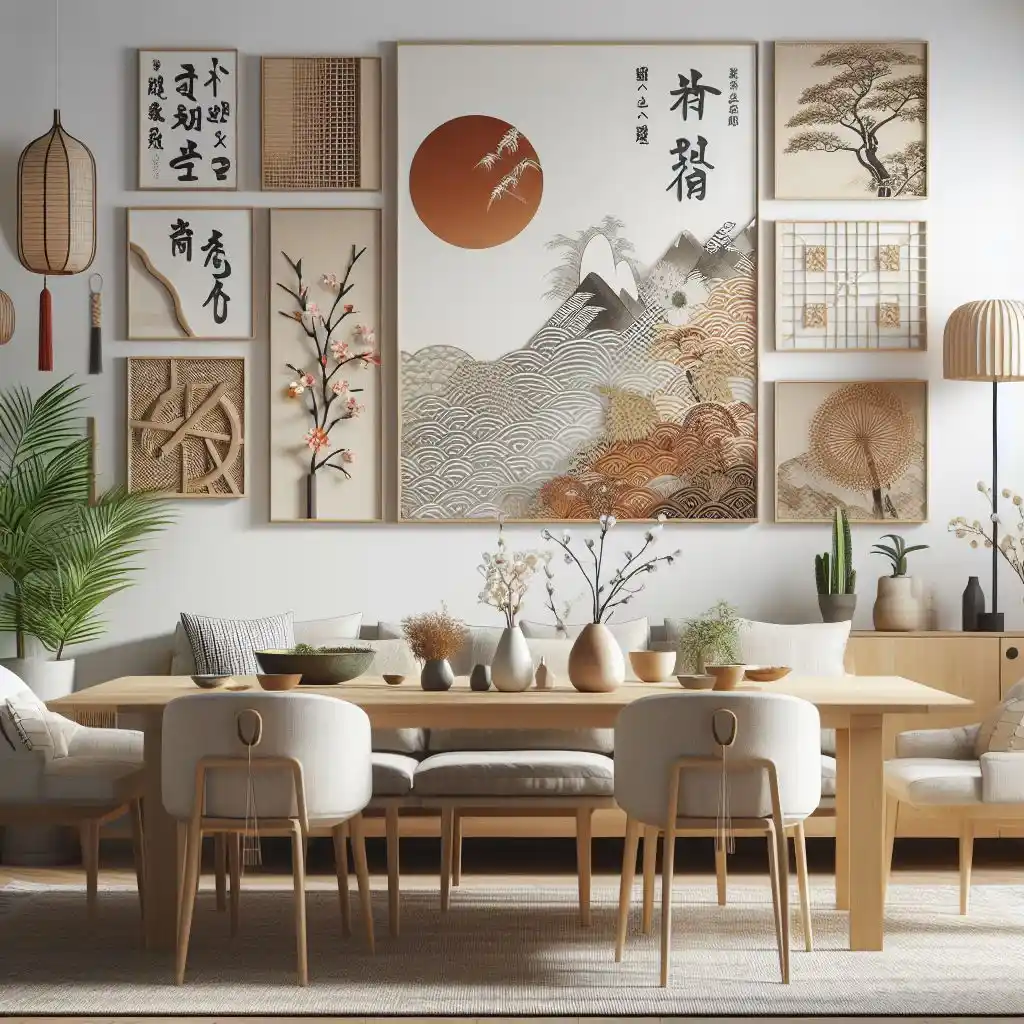
8. Seasonal Art Rotation
Change wall art according to the seasons, incorporating Japanese and Scandinavian elements for a dynamic ambiance.
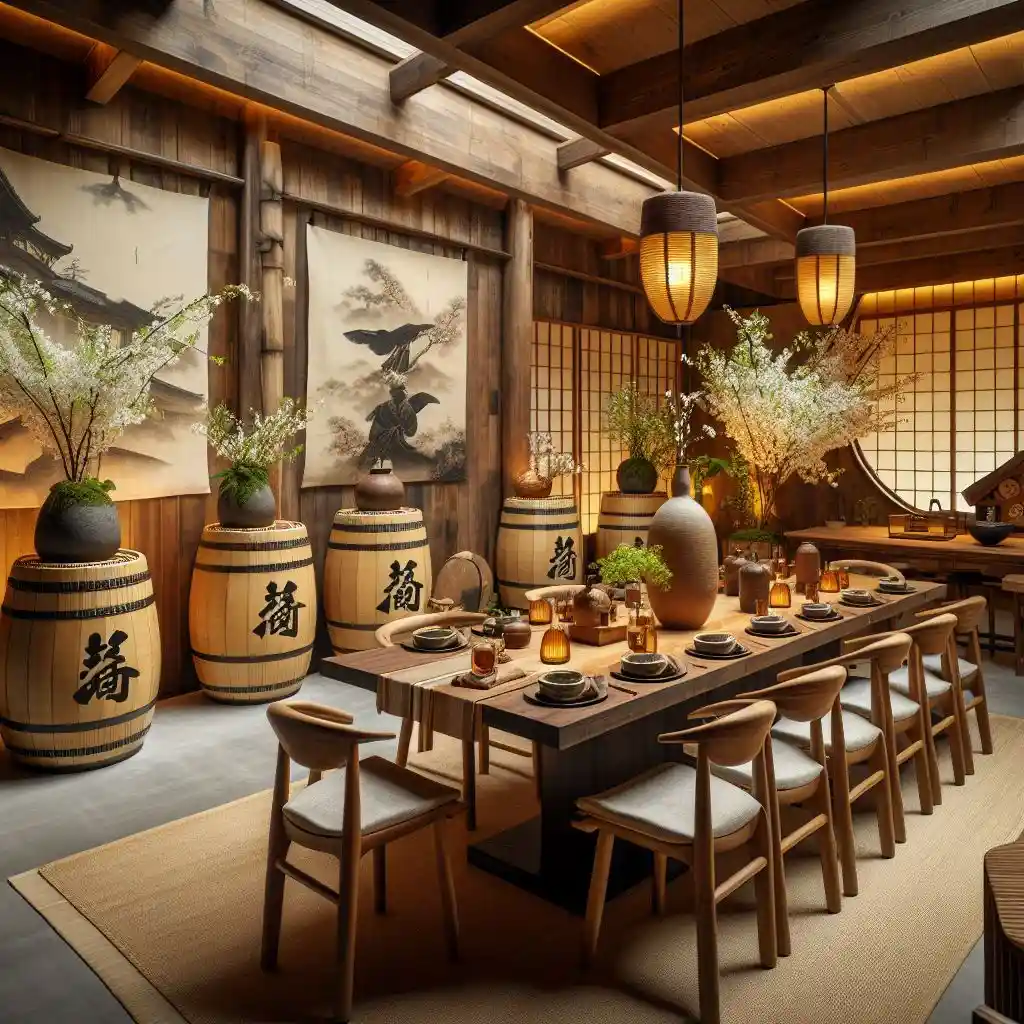
9. Sake Barrel Display
Repurpose sake barrels as decorative elements or storage units, showcasing the Japanese influence in the room.

10. Fabric Tapestry Divider
Use fabric tapestries with both Japanese and Scandinavian motifs as room dividers, adding a touch of warmth and cultural fusion.
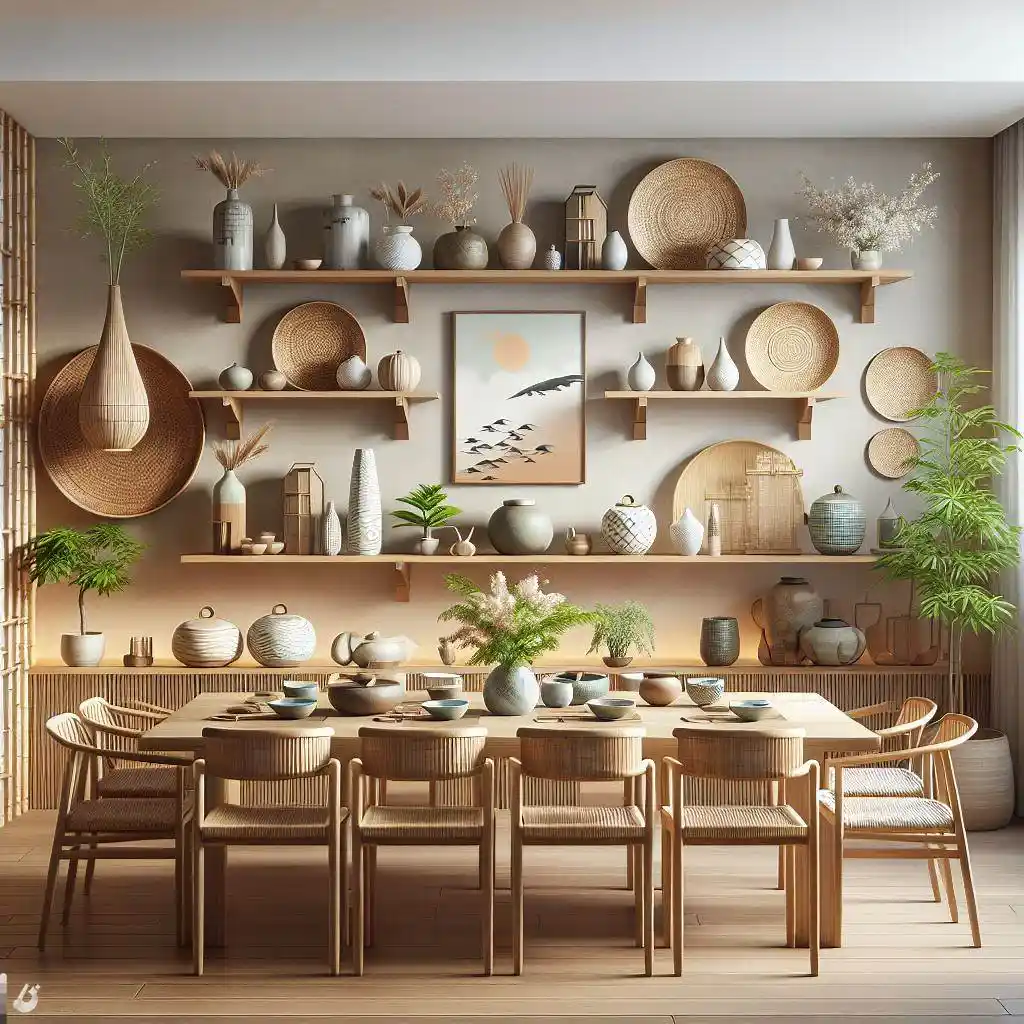
11. Floating Bamboo Shelves
Install floating bamboo shelves on the walls to display a mix of Japanese and Scandinavian ceramics, creating an engaging visual contrast.
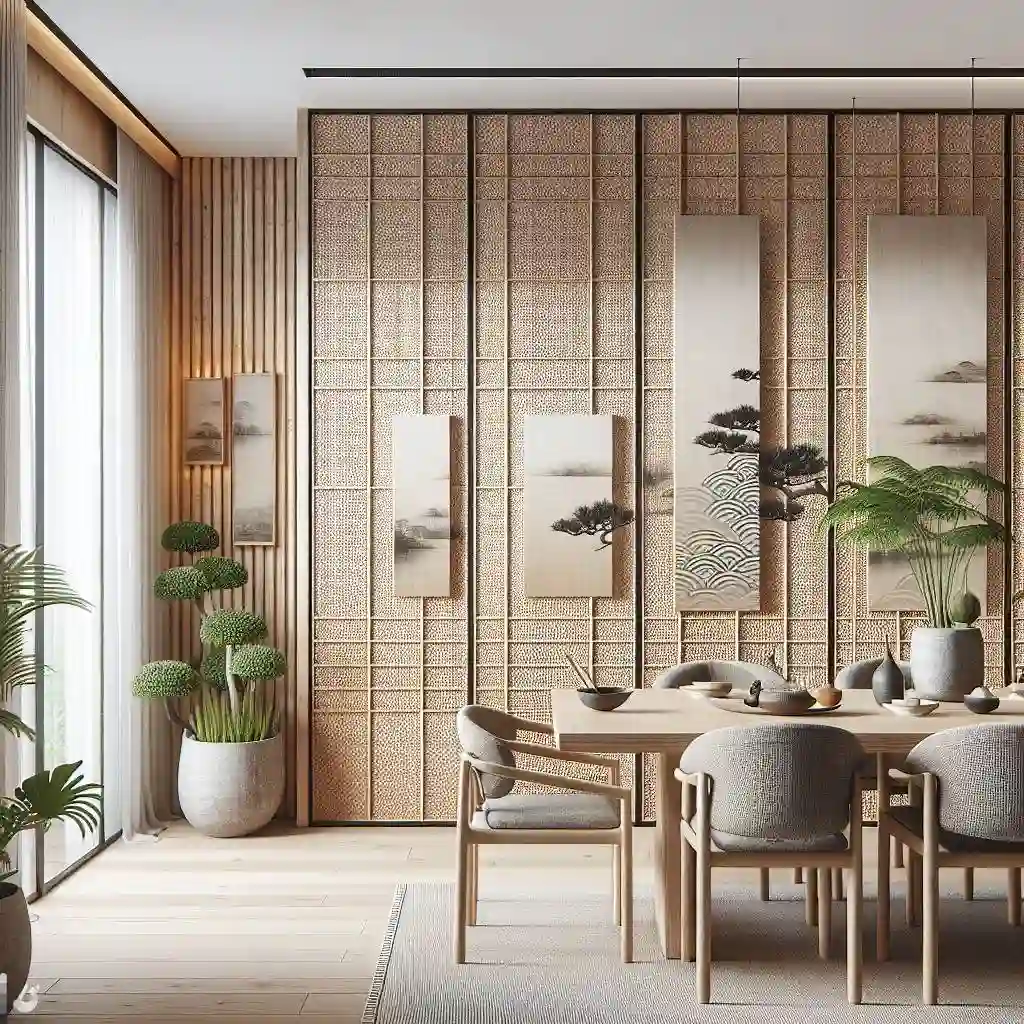
12. Textured Sliding Panels
Instead of traditional shoji screens, use textured sliding panels with patterns inspired by both cultures for a modern twist.
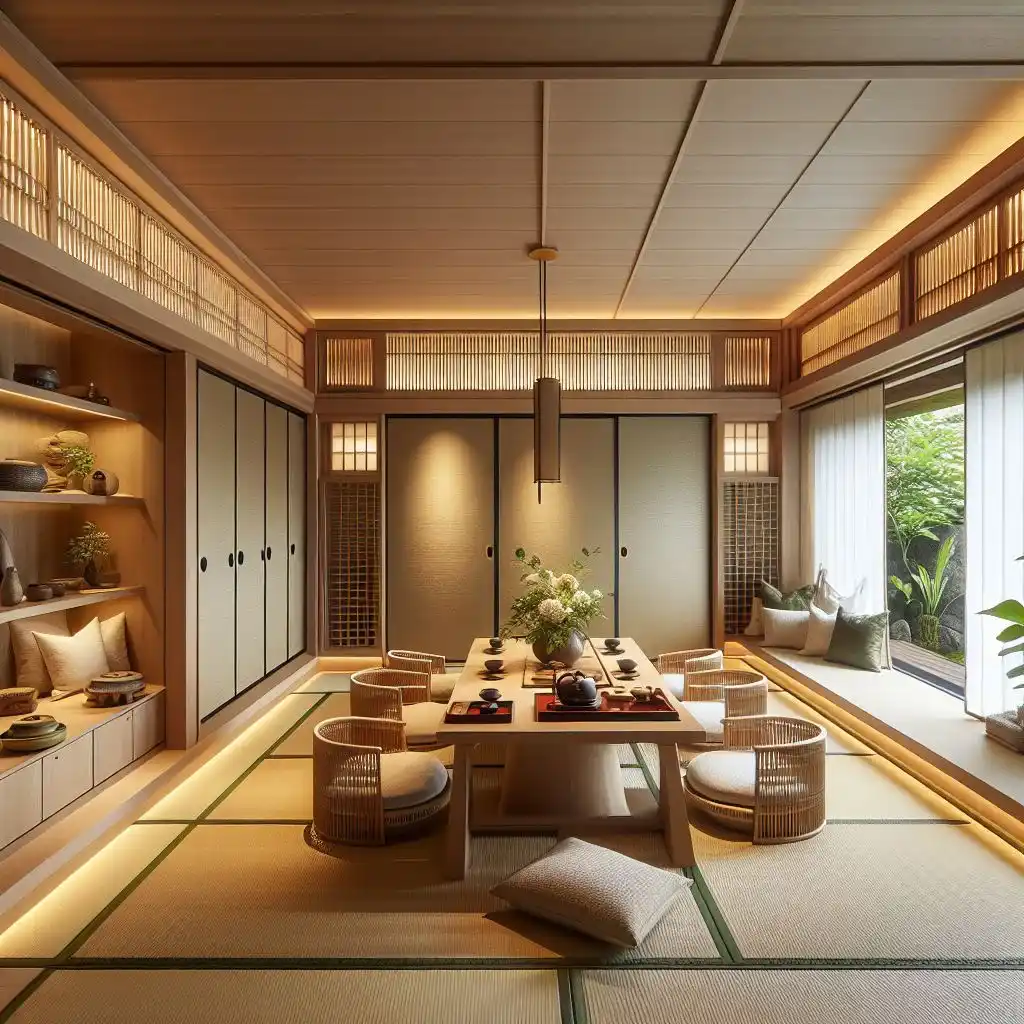
13. Hidden Tatami Storage
Incorporate hidden storage within Tatami flooring, blending traditional Japanese elements with practical Scandinavian functionality.
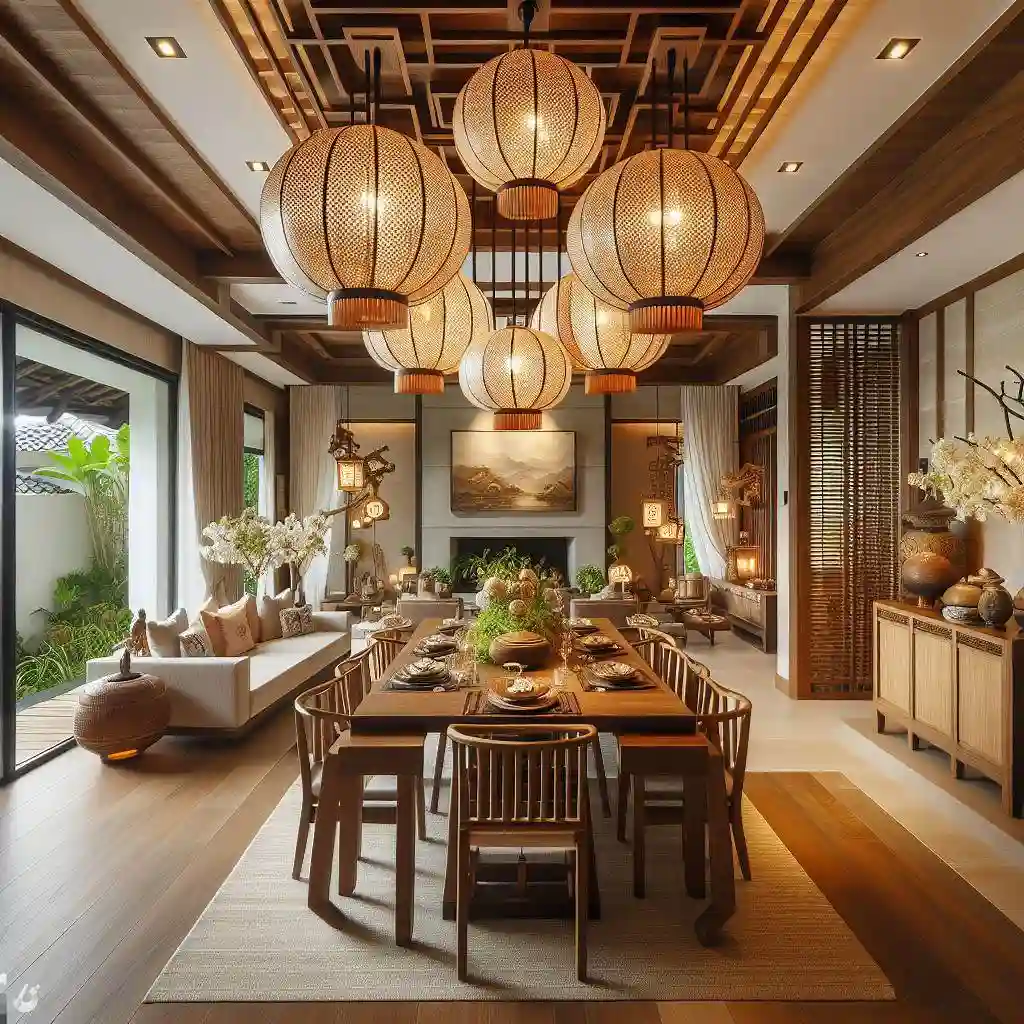
14. Teak and Paper Lantern Chandelier
Hang a chandelier made of teak wood and paper lanterns above the dining table, merging natural materials with soft lighting.
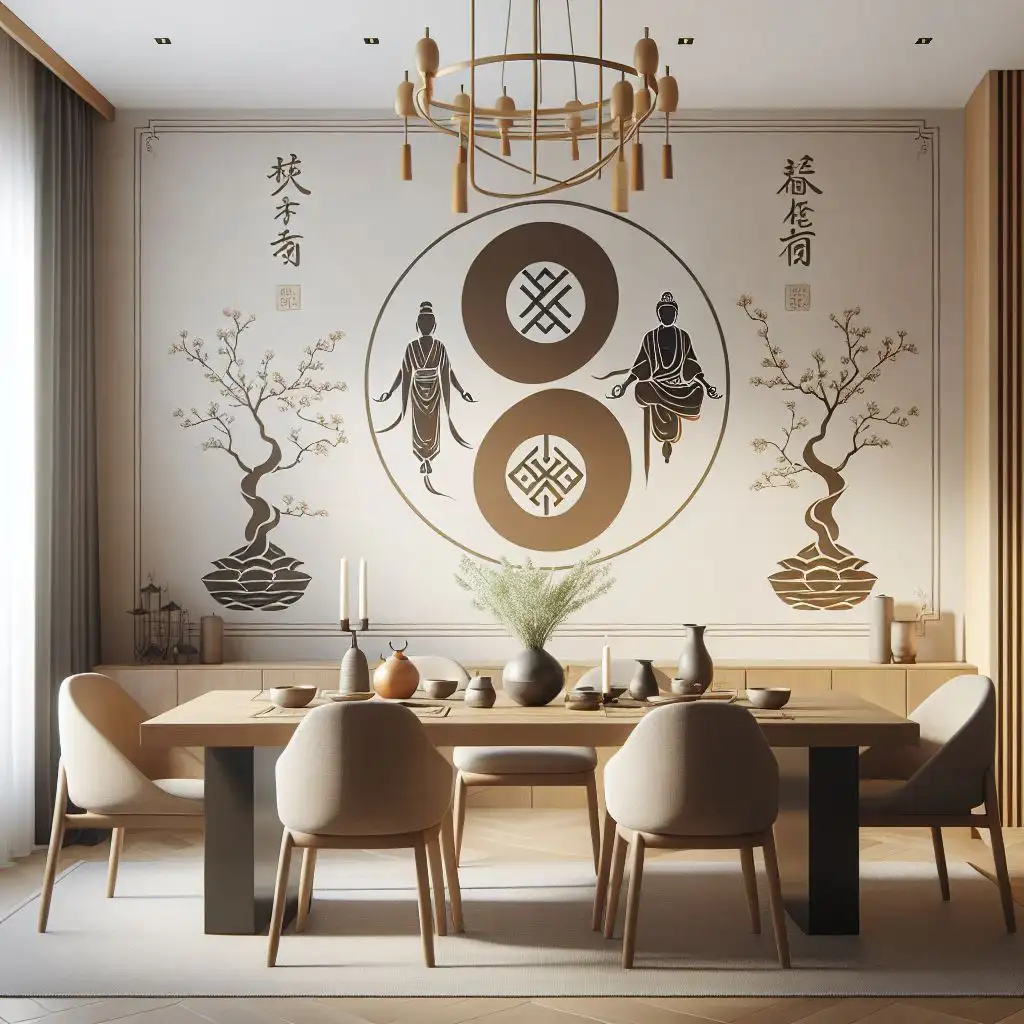
15. Harmony Wall Decals
Apply wall decals that represent harmony, balance, and unity, combining Japanese philosophical concepts with Scandinavian design principles.
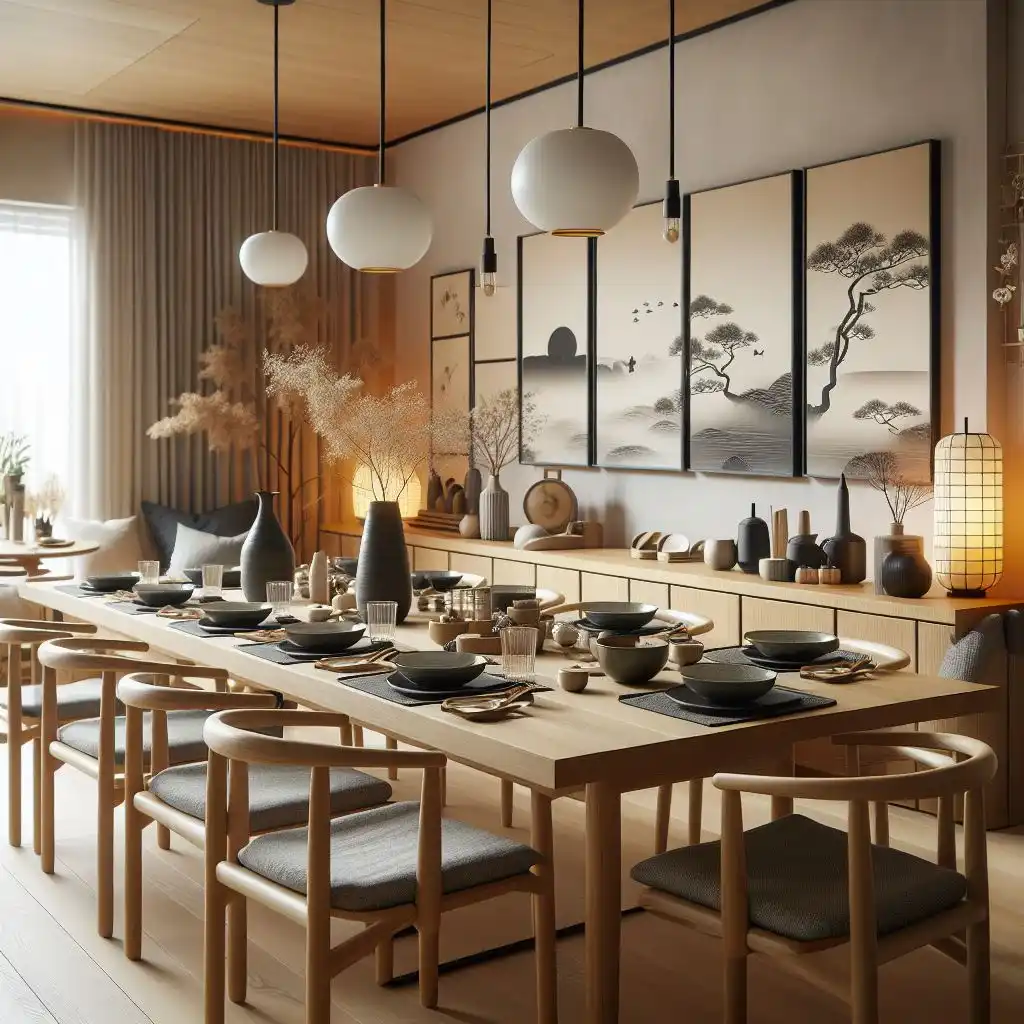
16. Custom Mismatched Tableware
Collect a set of intentionally mismatched Japanese and Scandinavian tableware for a charming and eclectic look.
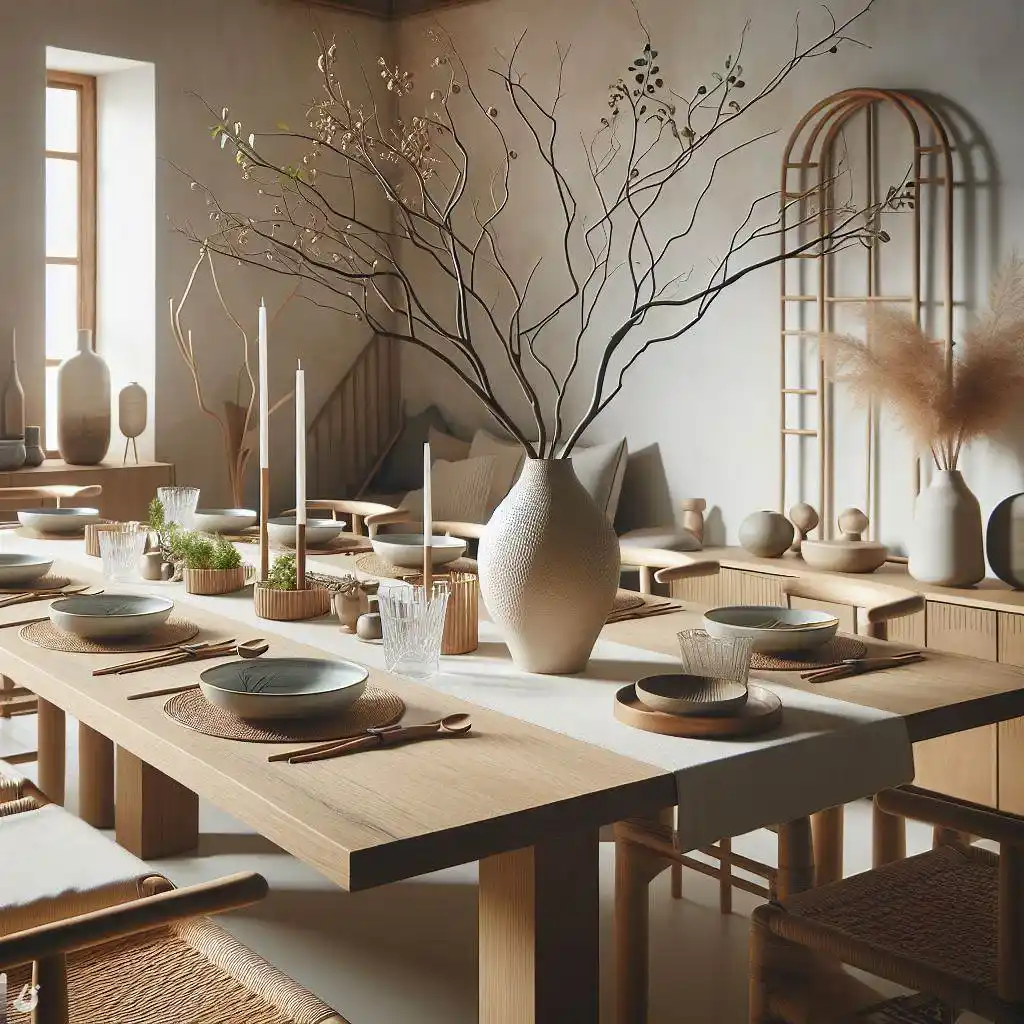
17. Branch-Inspired Centerpiece
Arrange a centerpiece using branches or twigs in a Scandinavian-style vase, complemented by minimalist Japanese tableware.

18. Framed Fabric Artwork
Frame traditional Japanese fabrics or textiles as artwork, adding texture and cultural richness to the dining room.
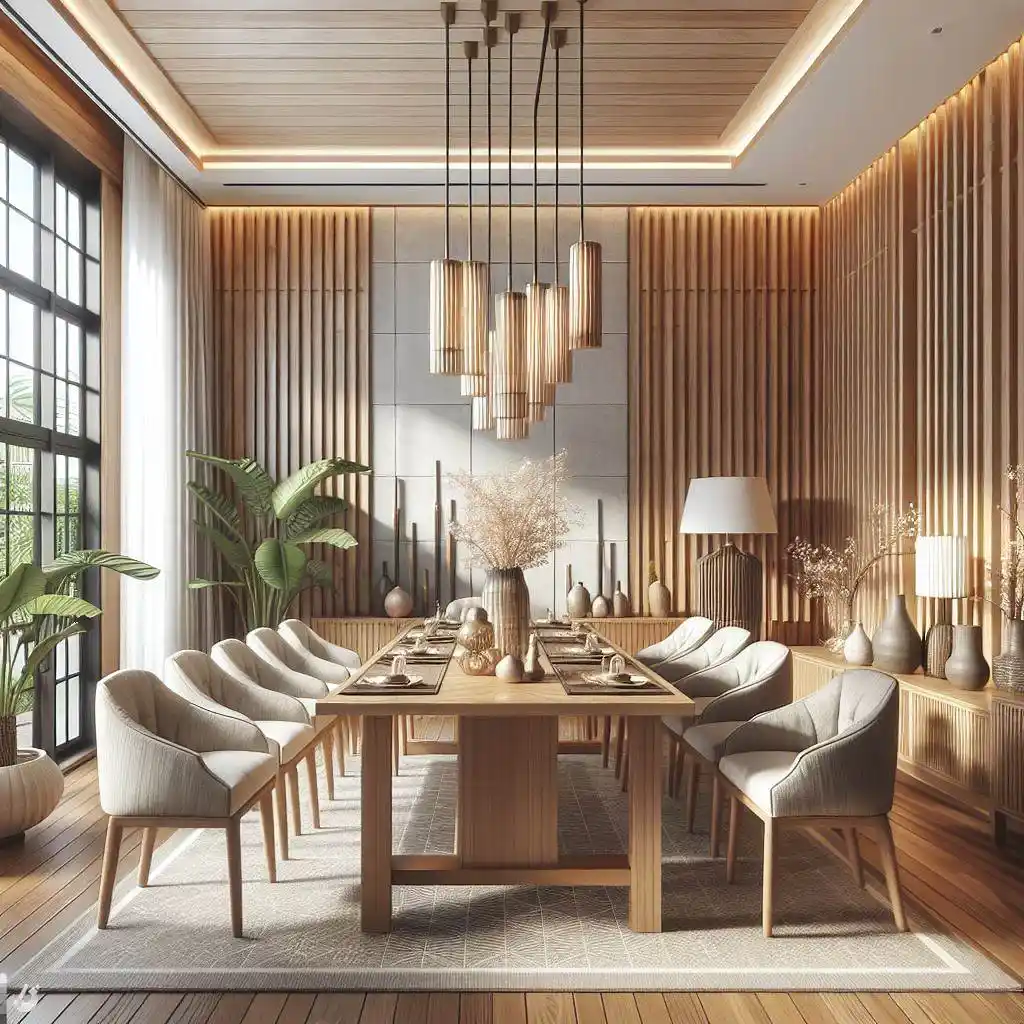
19. Linear Wood Paneling
Install linear wood paneling on one accent wall, creating a seamless blend of Scandinavian and Japanese linear design elements.
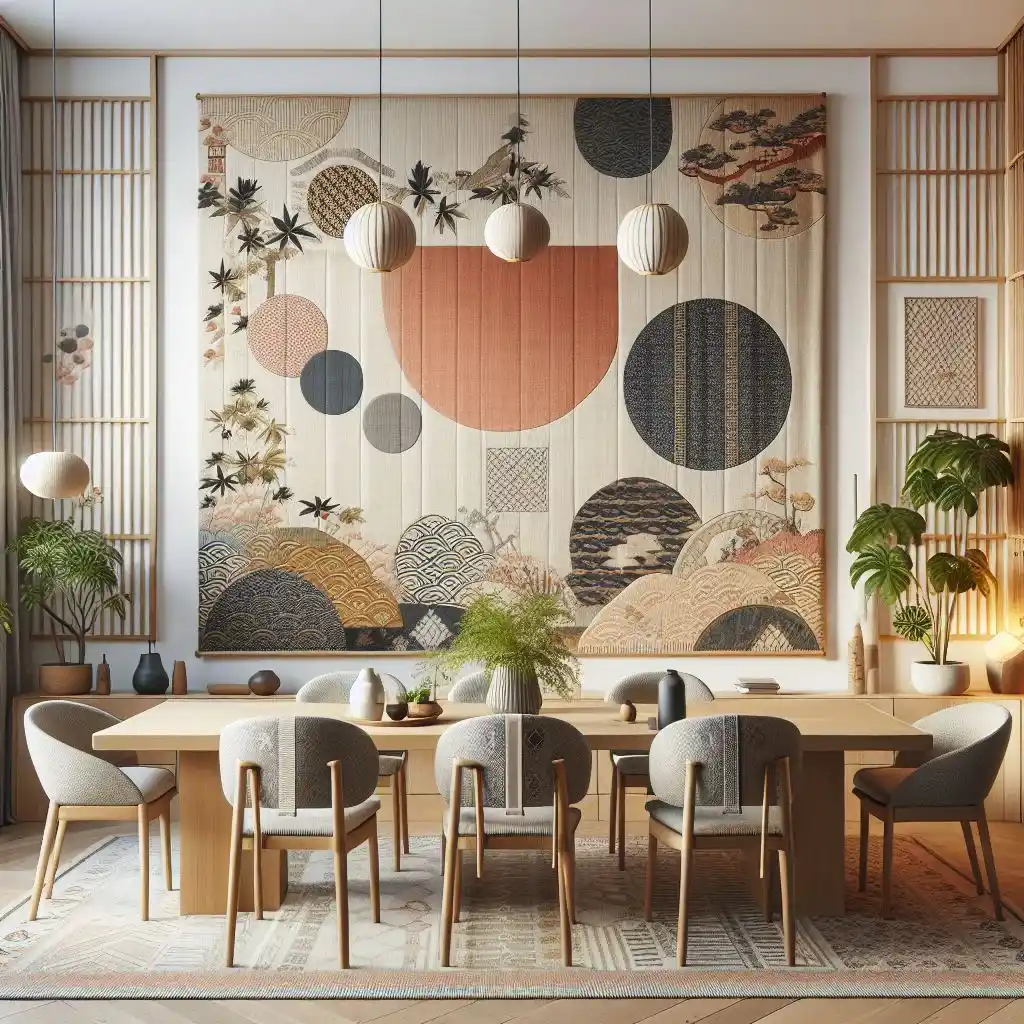
20. Japanese Textile Wall Hanging
Hang a large textile wall hanging with patterns that merge Japanese and Scandinavian textile traditions.
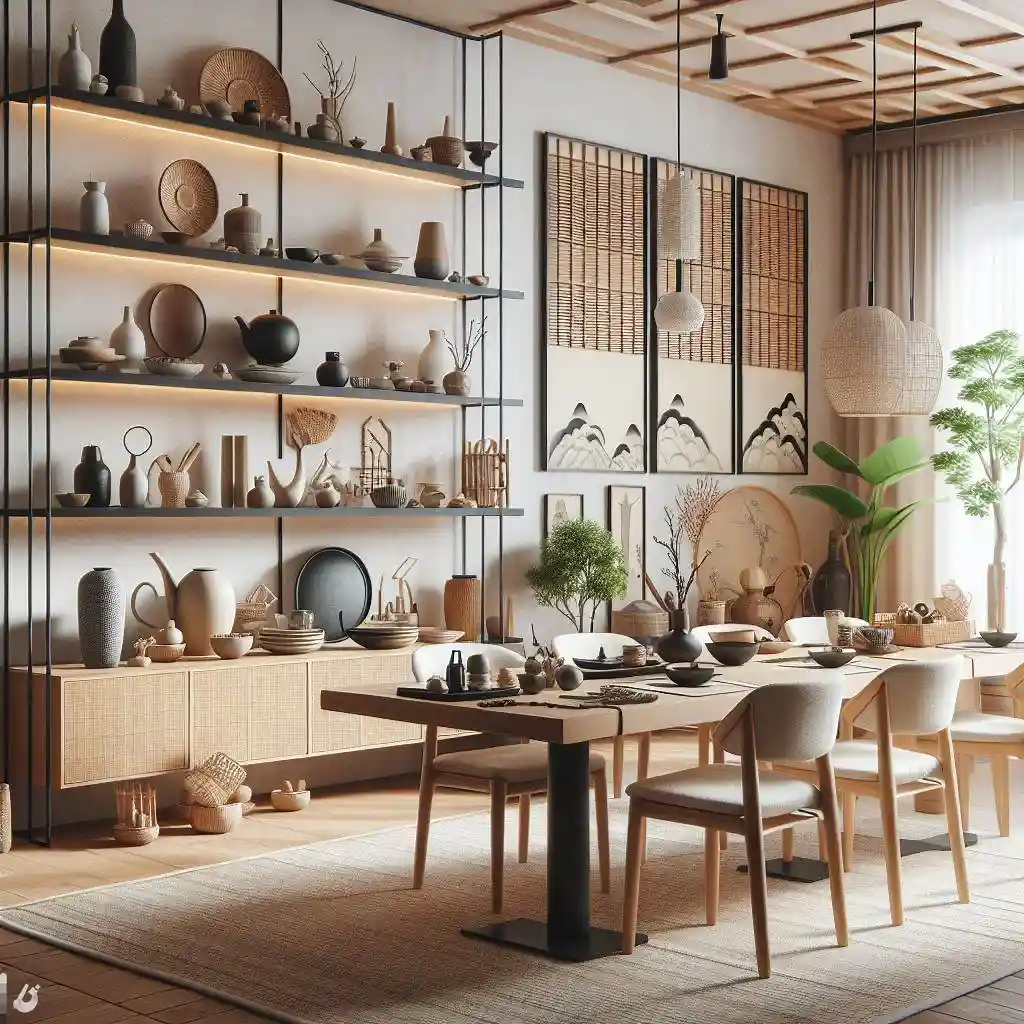
21. Scandinavian-Styled Shelves
Install open shelves with clean lines and a light finish, displaying a curated Japanese and Scandinavian décor collection.
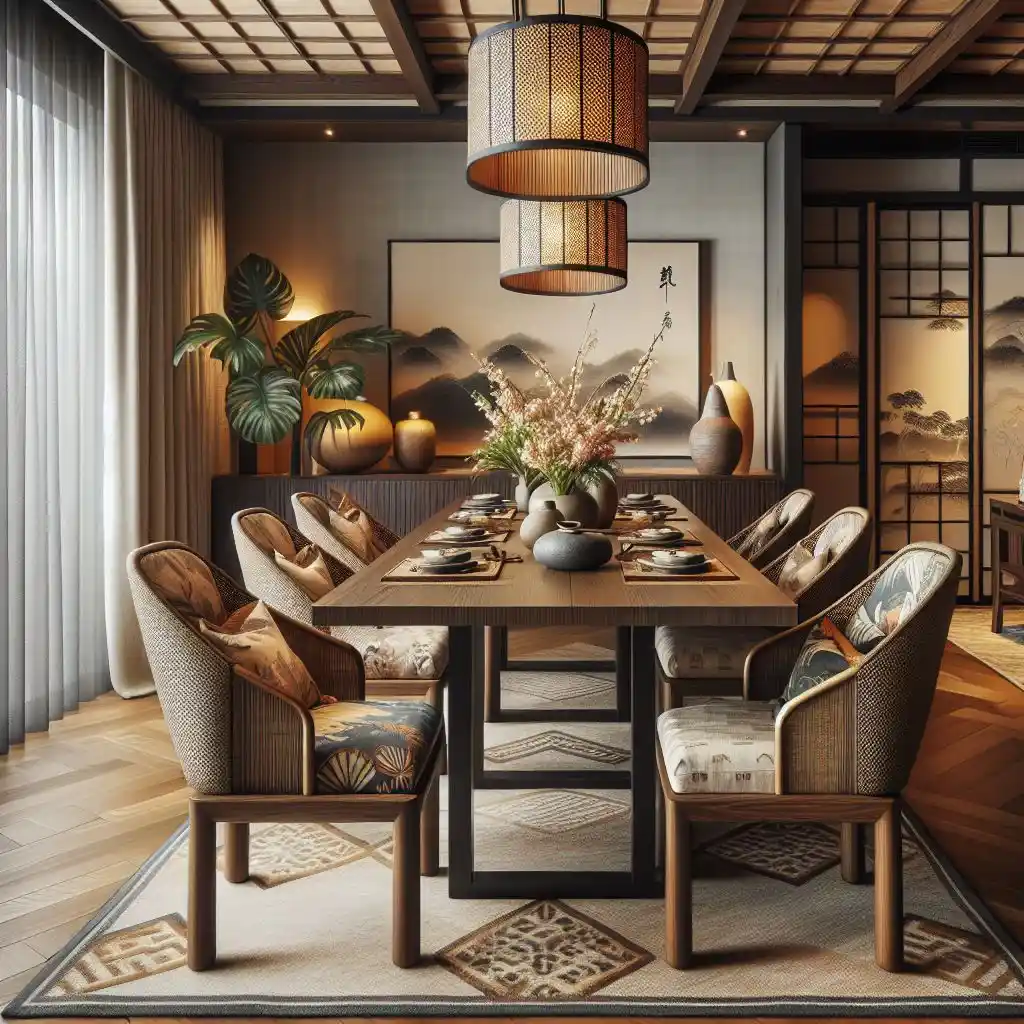
22. Kimono Upholstered Chairs
Upholstered dining chairs with fabric inspired by traditional Japanese kimonos add a touch of elegance.
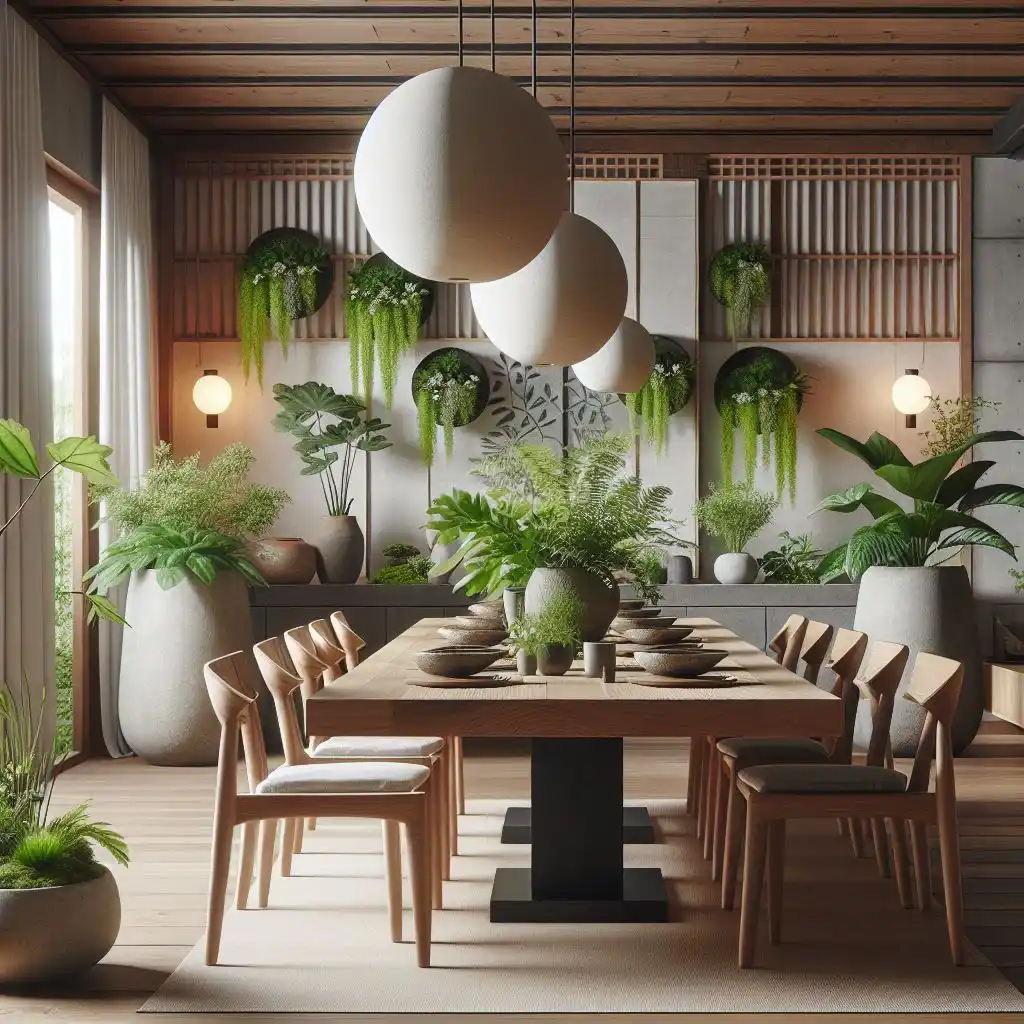
23. Concrete and Moss Planters
Combine concrete planters with mossy green plants for an industrial-meets-nature vibe inspired by both cultures.
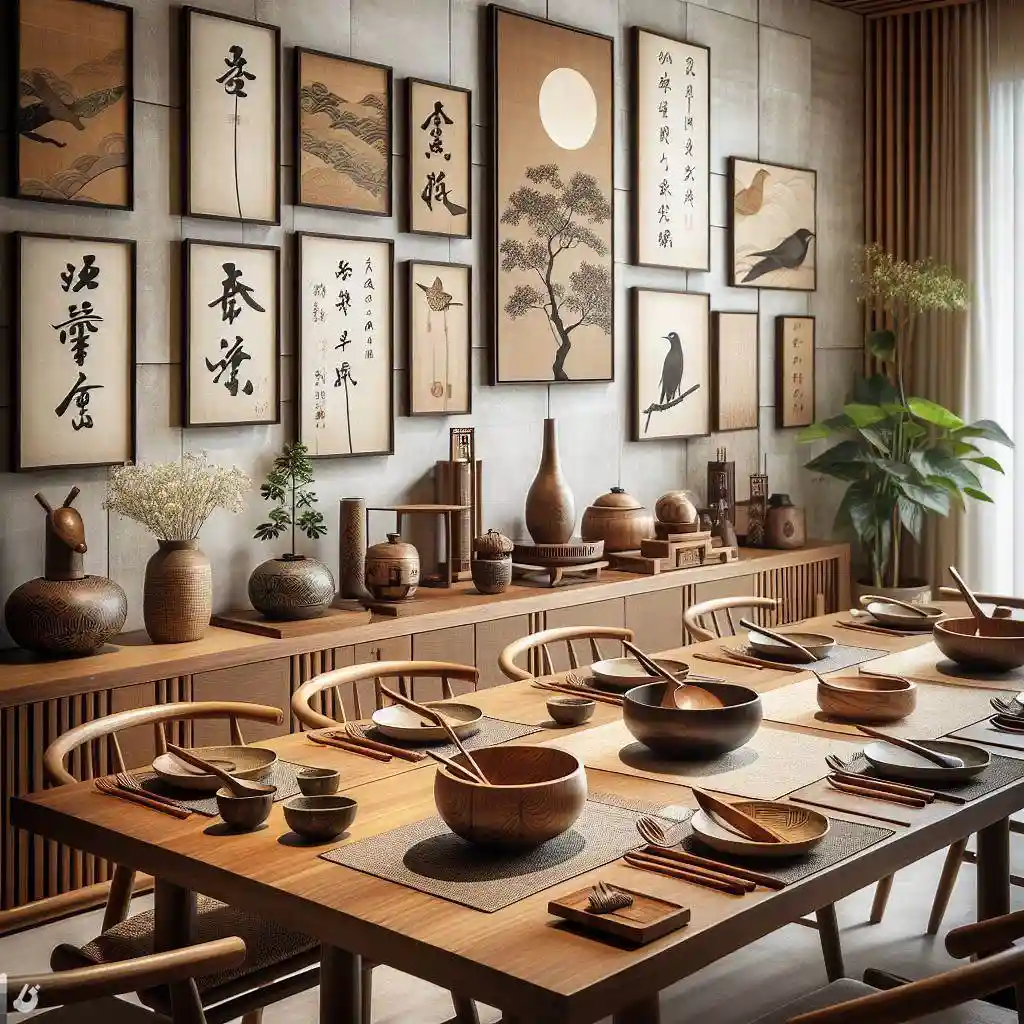
24. Handcrafted Wooden Utensils
Showcase handcrafted wooden utensils in a prominent place, highlighting the craftsmanship of both Japanese and Scandinavian traditions.
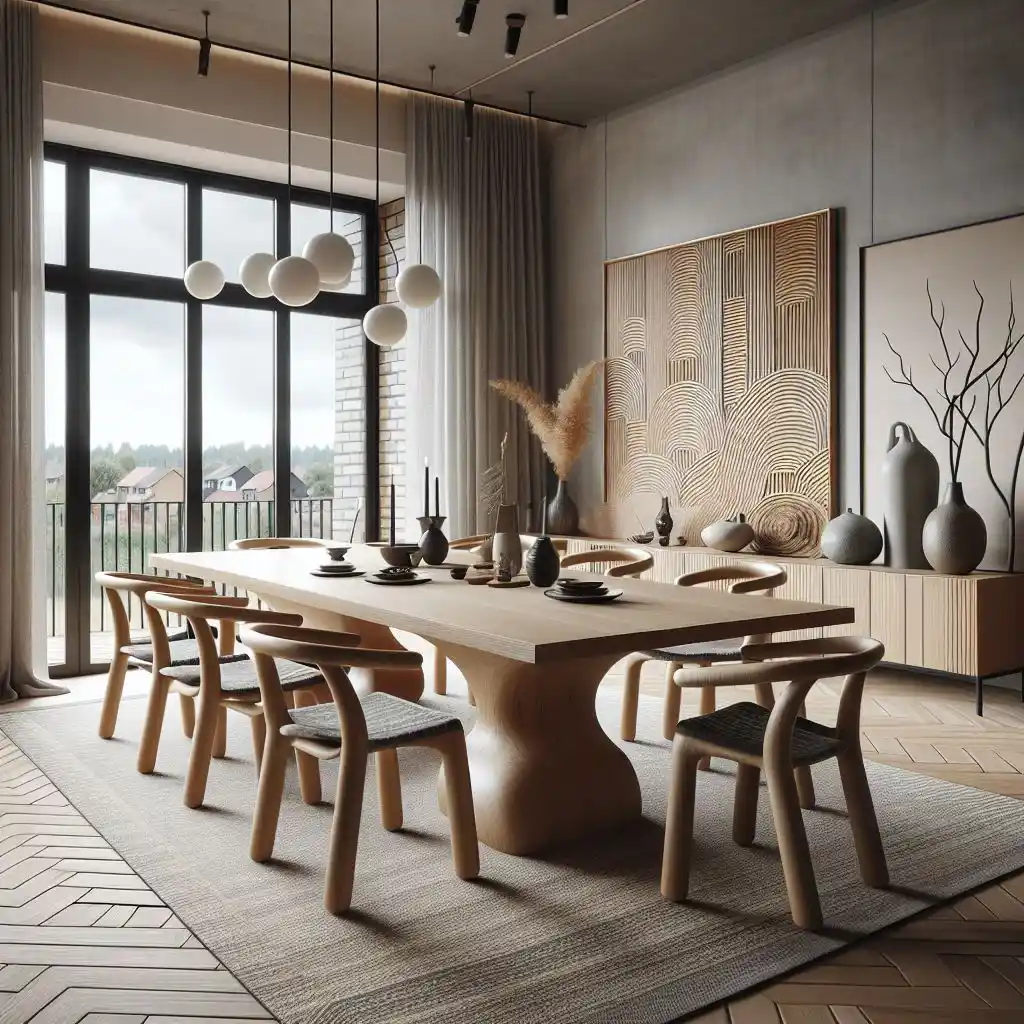
25. Sculptural Table Legs
Opt for a dining table with sculptural legs inspired by Japanese and Scandinavian design aesthetics.
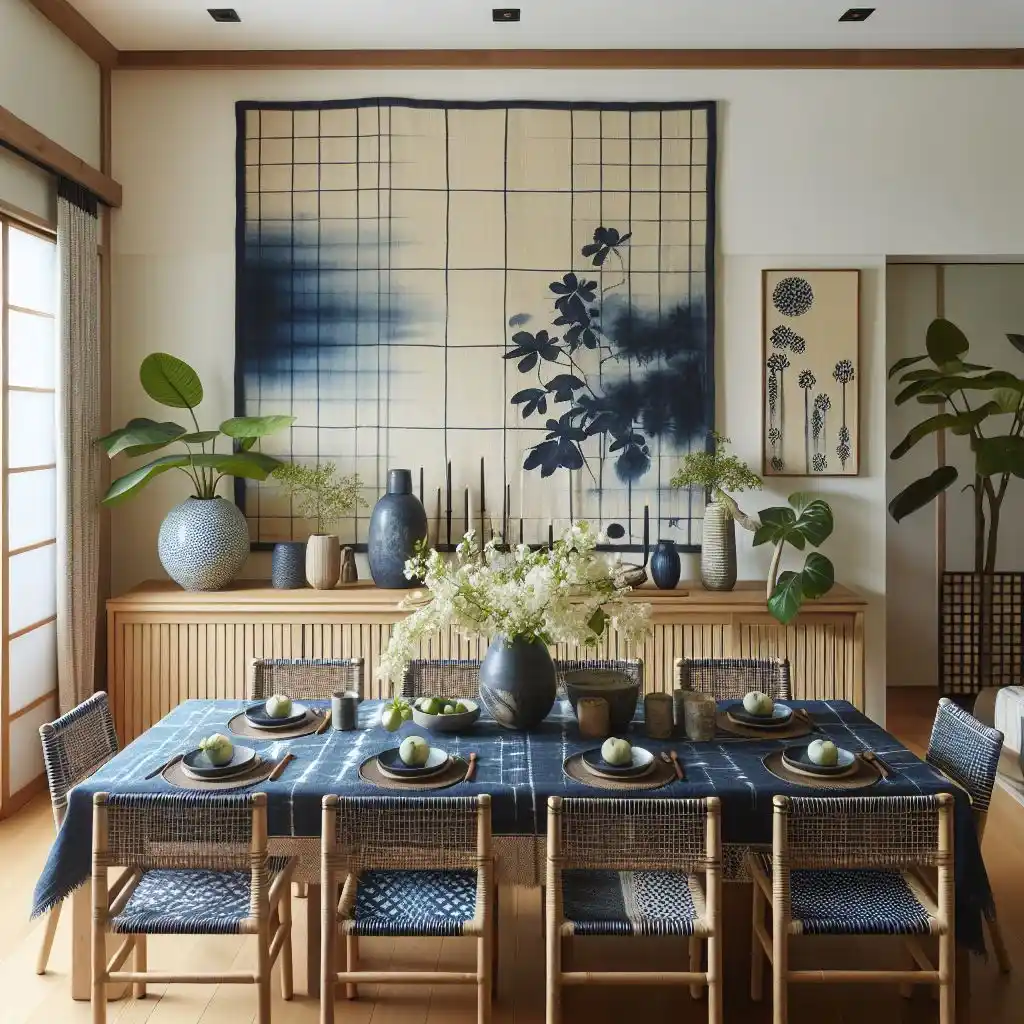
26. Indigo Shibori Table Runner
Lay an indigo-dyed Shibori table runner across the dining table, seamlessly blending Japanese textile art with Scandinavian simplicity.
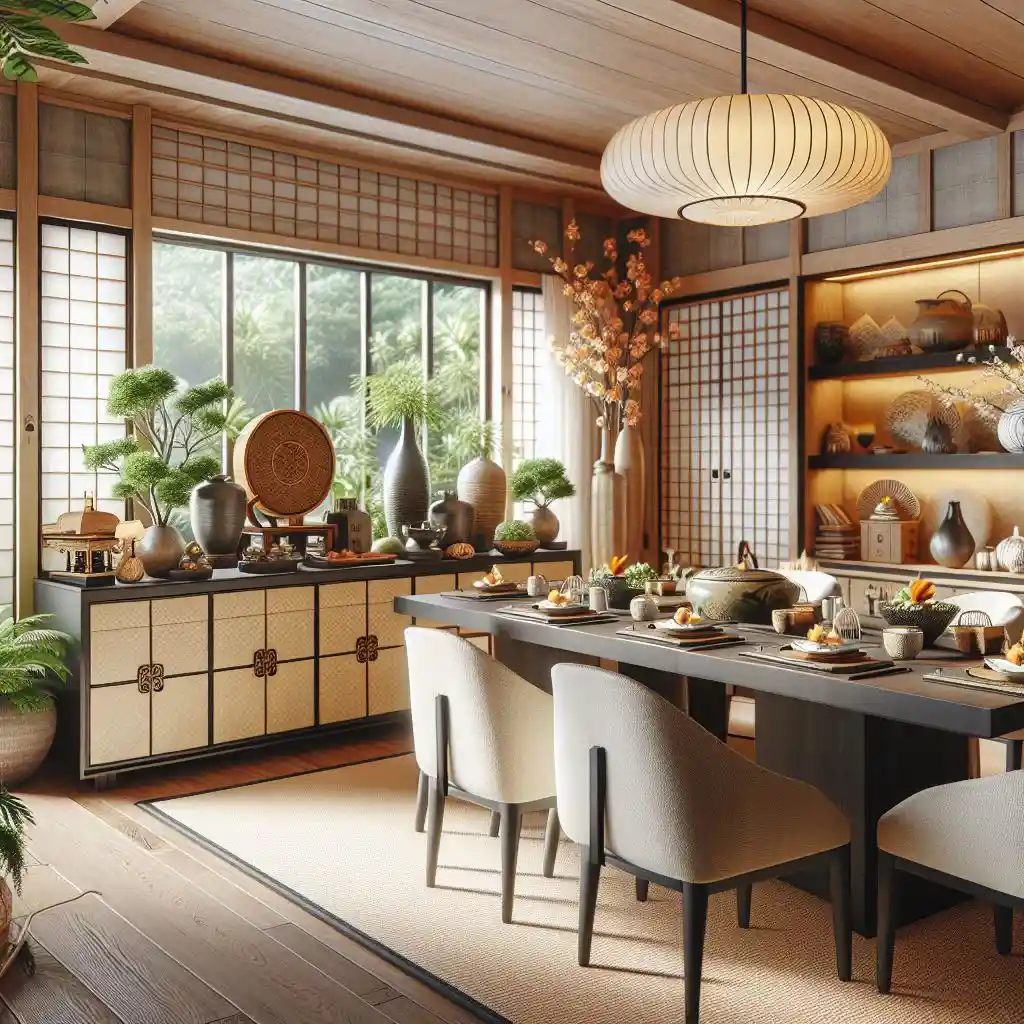
27. Tansu Cabinet Buffet
Using a Tansu-style cabinet as a buffet combines Japanese craftsmanship with Scandinavian functionality.

28. Foldable Dining Screen
Employ a foldable dining screen with Japanese and Scandinavian design elements, allowing for flexible use and aesthetic appeal.
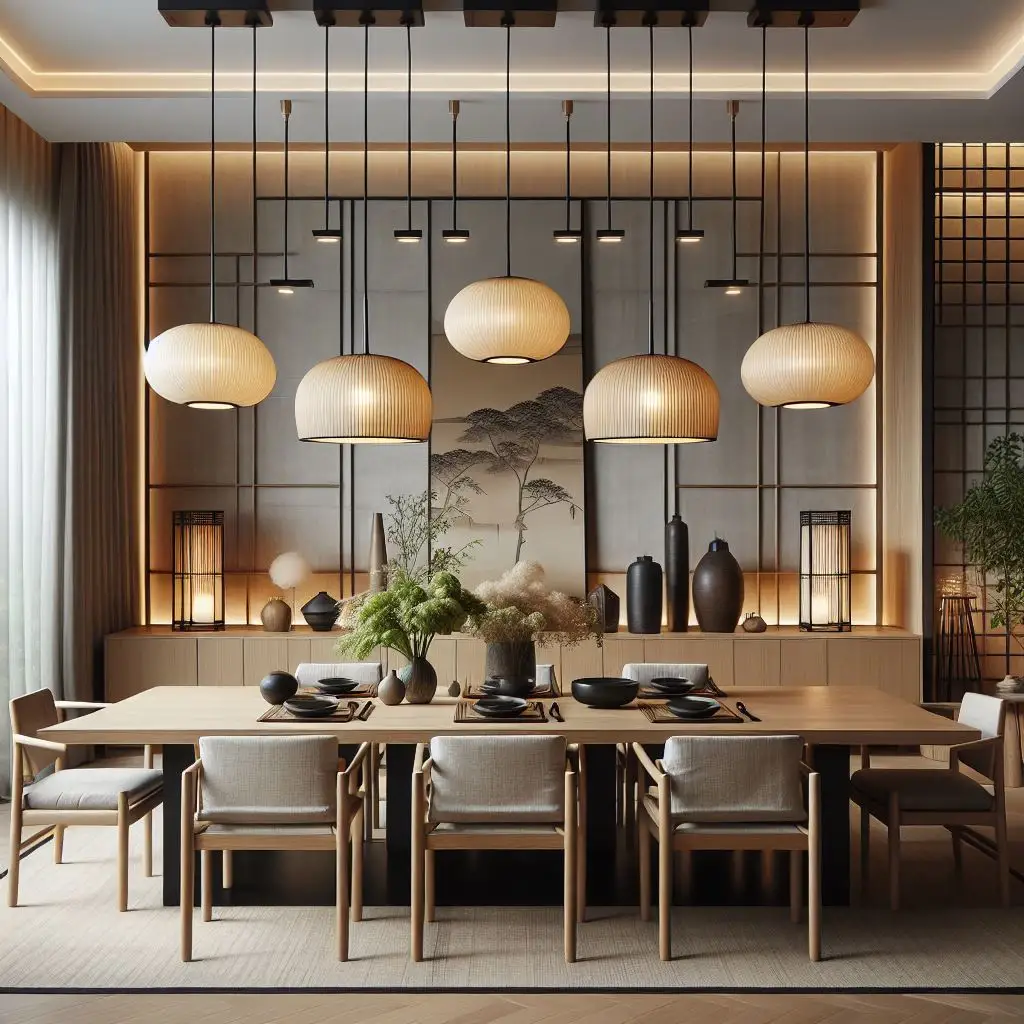
29. Linear Pendant Lighting
Install linear pendant lights above the dining table, resembling Japanese lanterns and Scandinavian sleek designs.
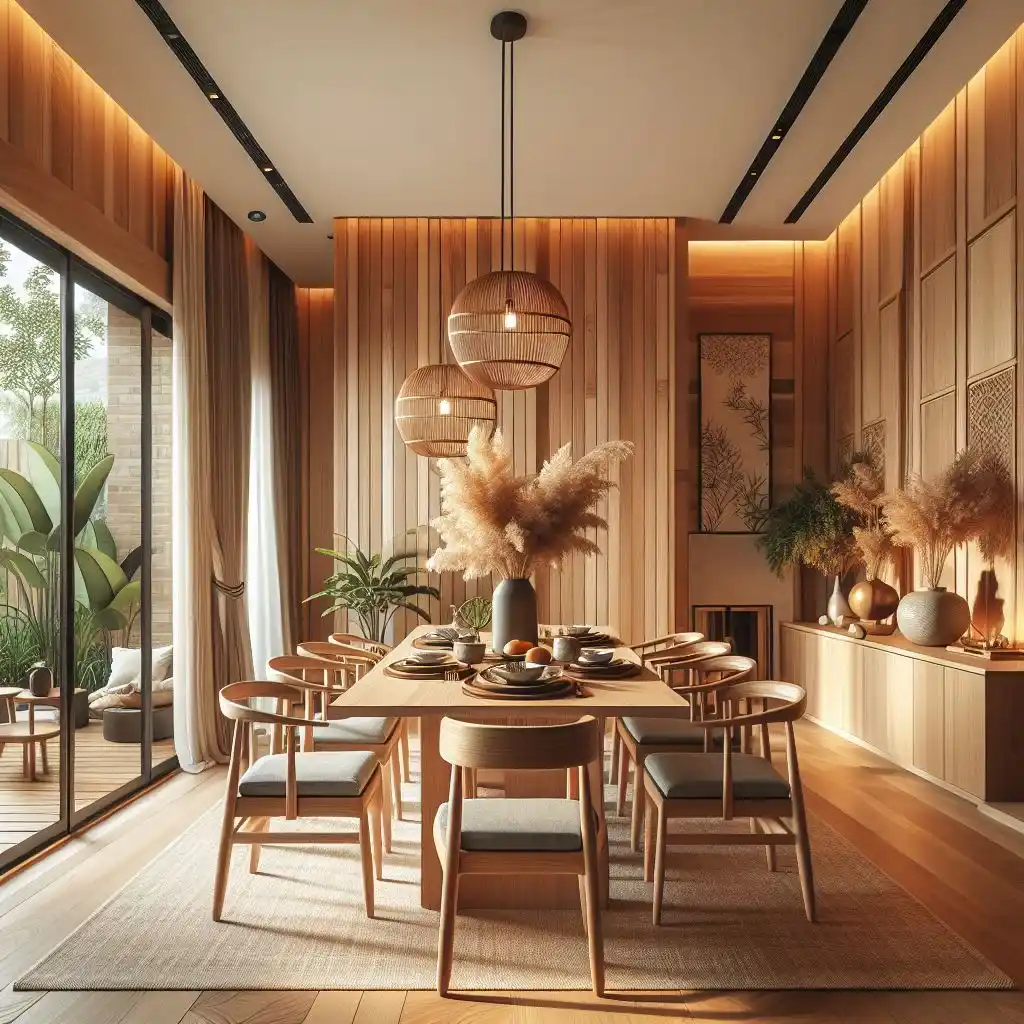
30. Maple Wood Accents
Introduce warm maple wood accents, such as chair legs or tabletop details, for a touch of Scandinavian coziness.
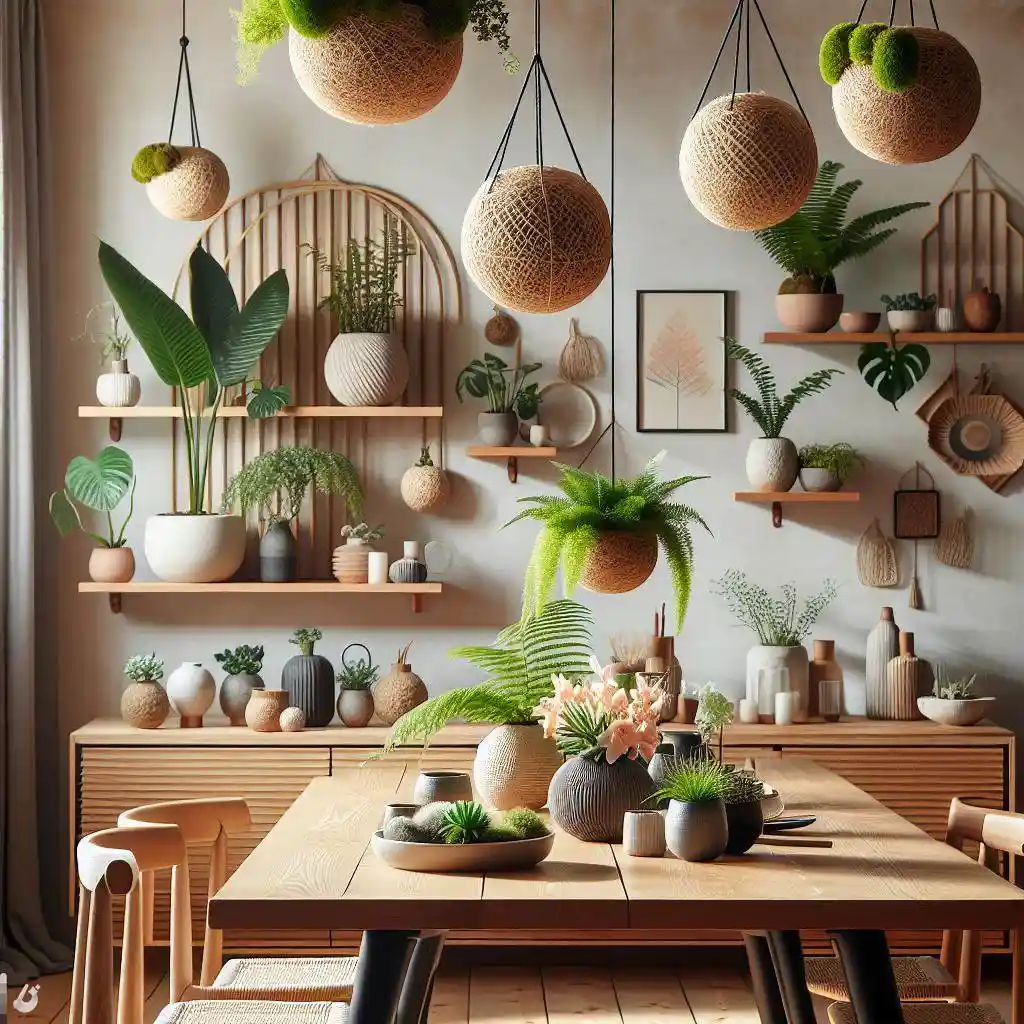
31. Kokedama Plant Arrangements
Display Kokedama, Japanese moss ball plant arrangements, in Scandinavian-style hanging planters for a unique green element.
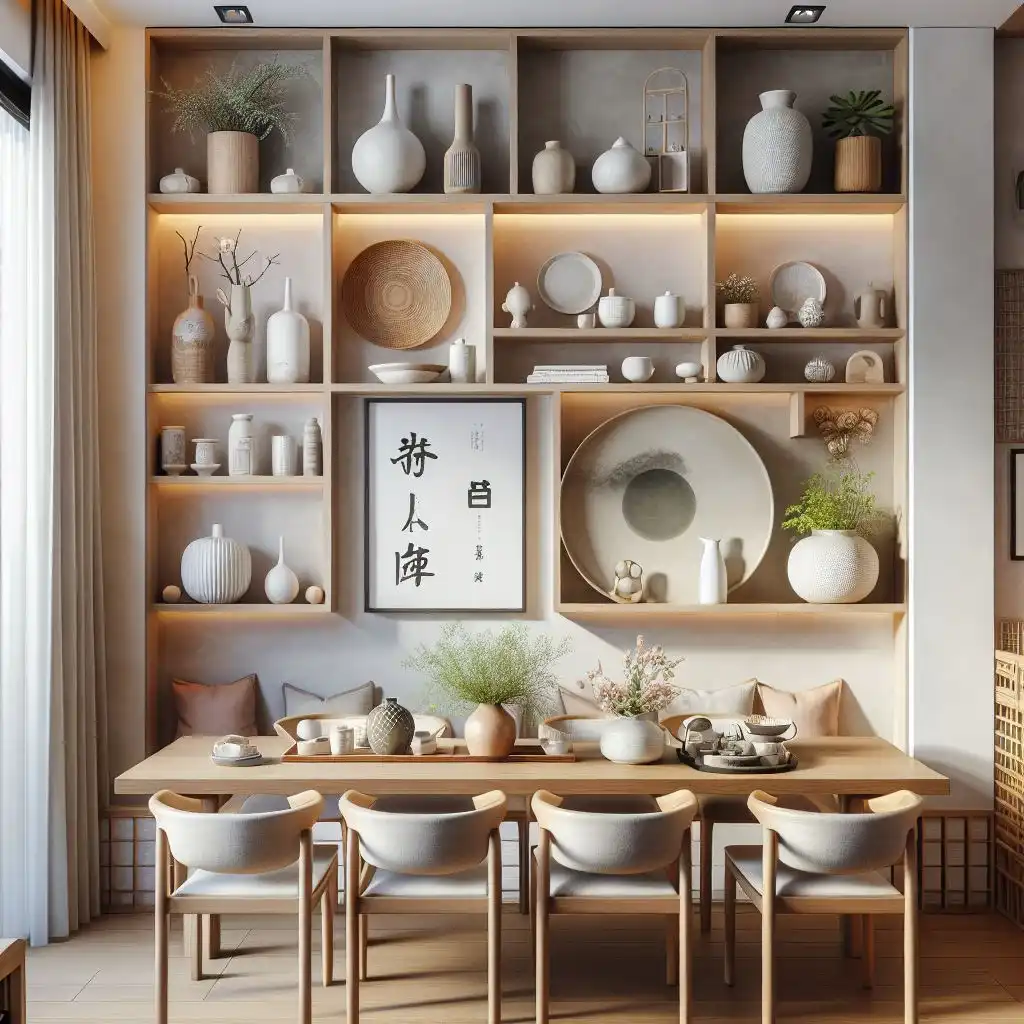
32. Japanese Wall Niche
Create a wall niche with built-in shelves to display small, curated items representing Japanese and Scandinavian design philosophies.
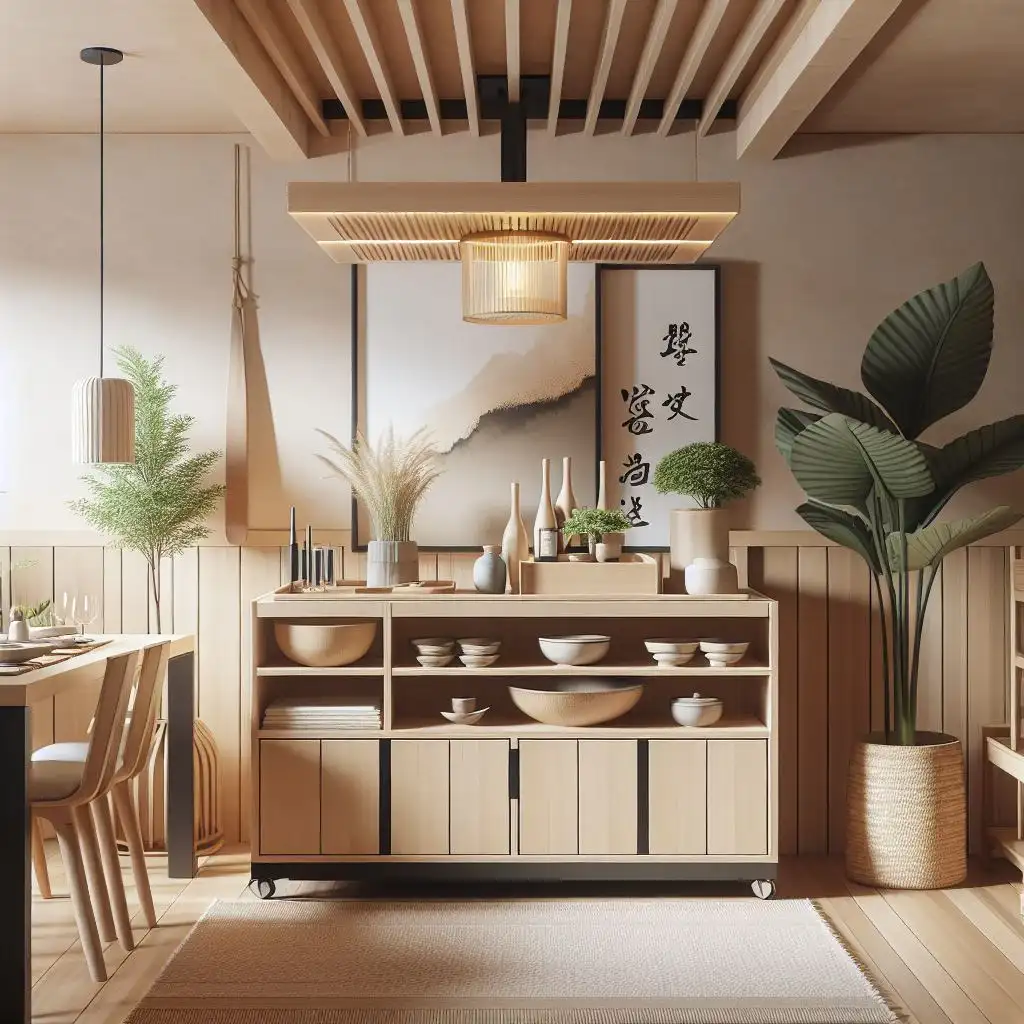
33. Movable Dining Cart
Incorporate a movable dining cart with clean lines and functional storage, inspired by both cultures’ emphasis on practicality.
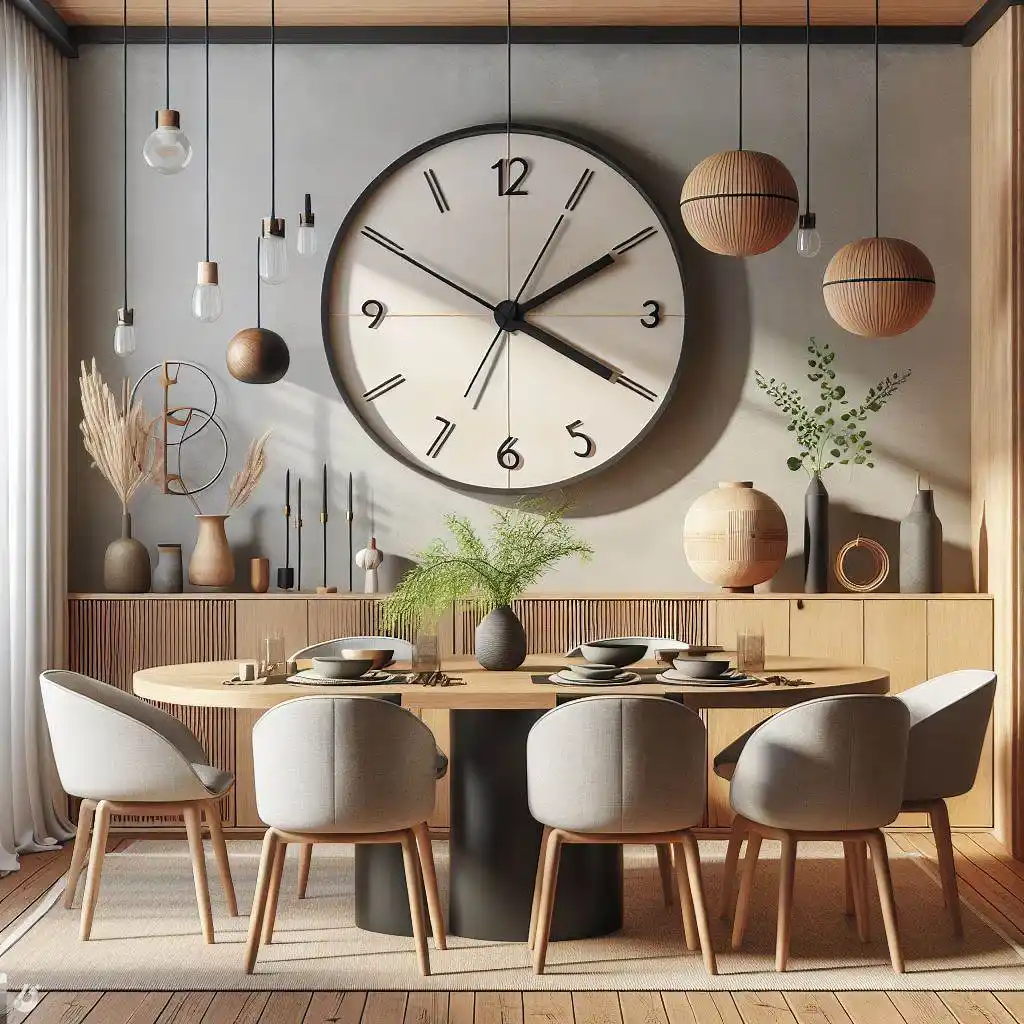
34. Nordic Japandi Wall Clock
Hang a wall clock that fuses Nordic minimalism with traditional Japanese design elements, creating a functional yet artistic piece.
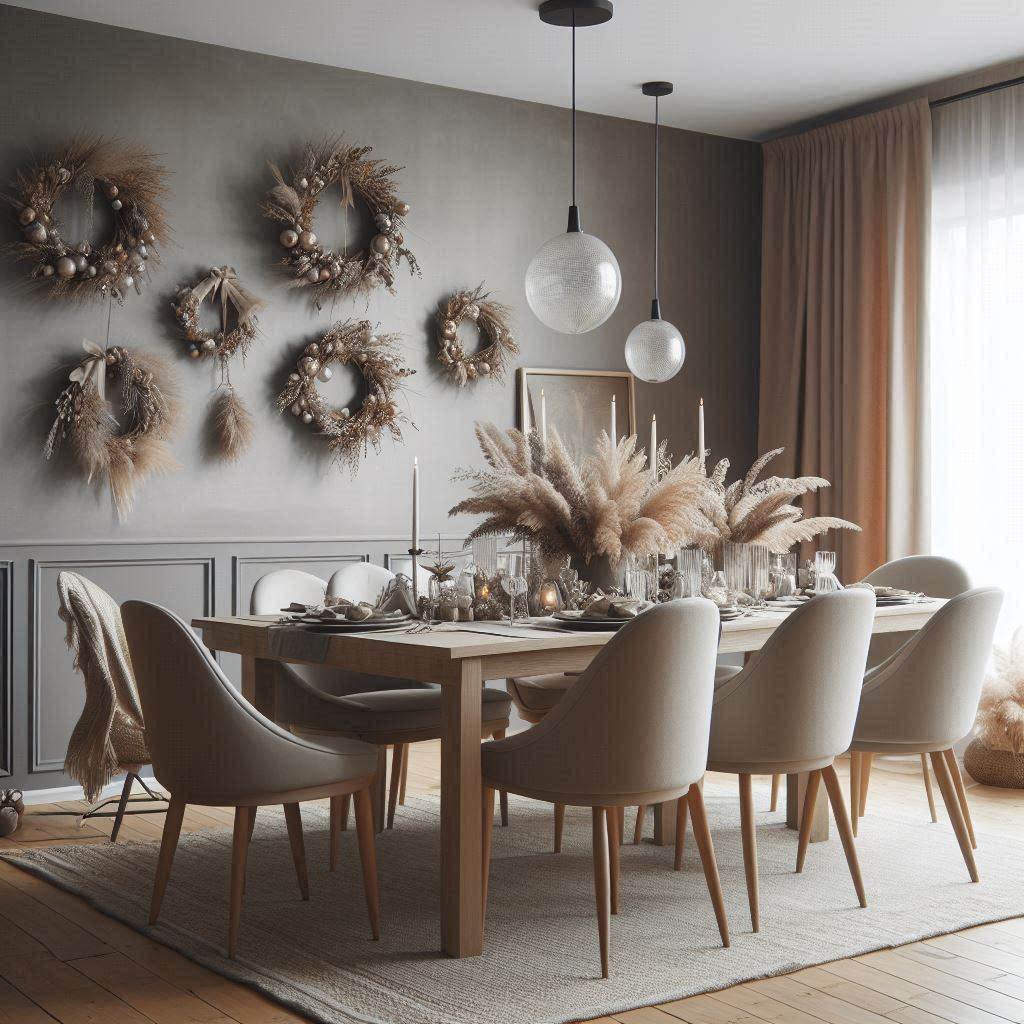
35. Seasonal Wreaths
Decorate the dining area with seasonal wreaths made from natural materials, combining Scandinavian and Japanese appreciation for nature.
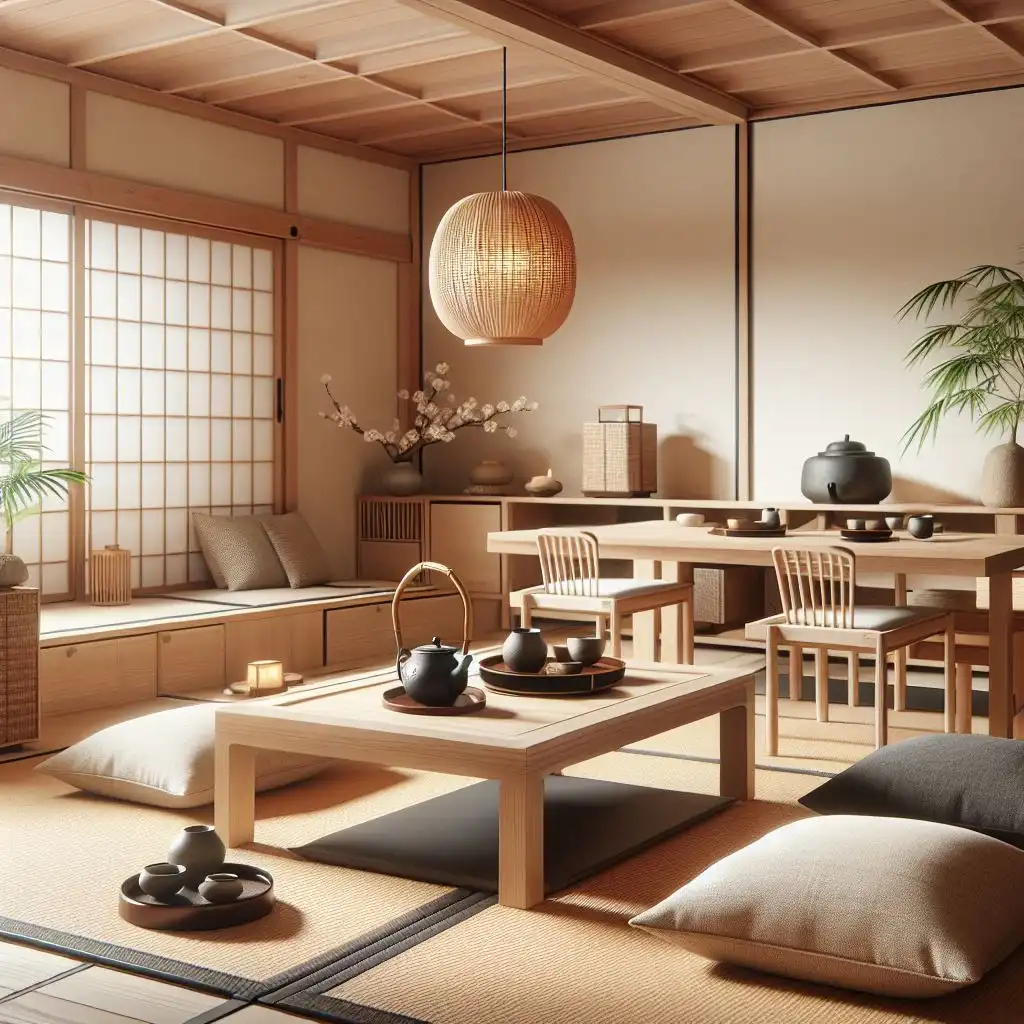
36. Tea Ceremony Corner
Dedicate a corner for a simplified tea ceremony setup with a low table, floor cushions, and bamboo accessories, blending Japanese ritual with Scandinavian comfort.
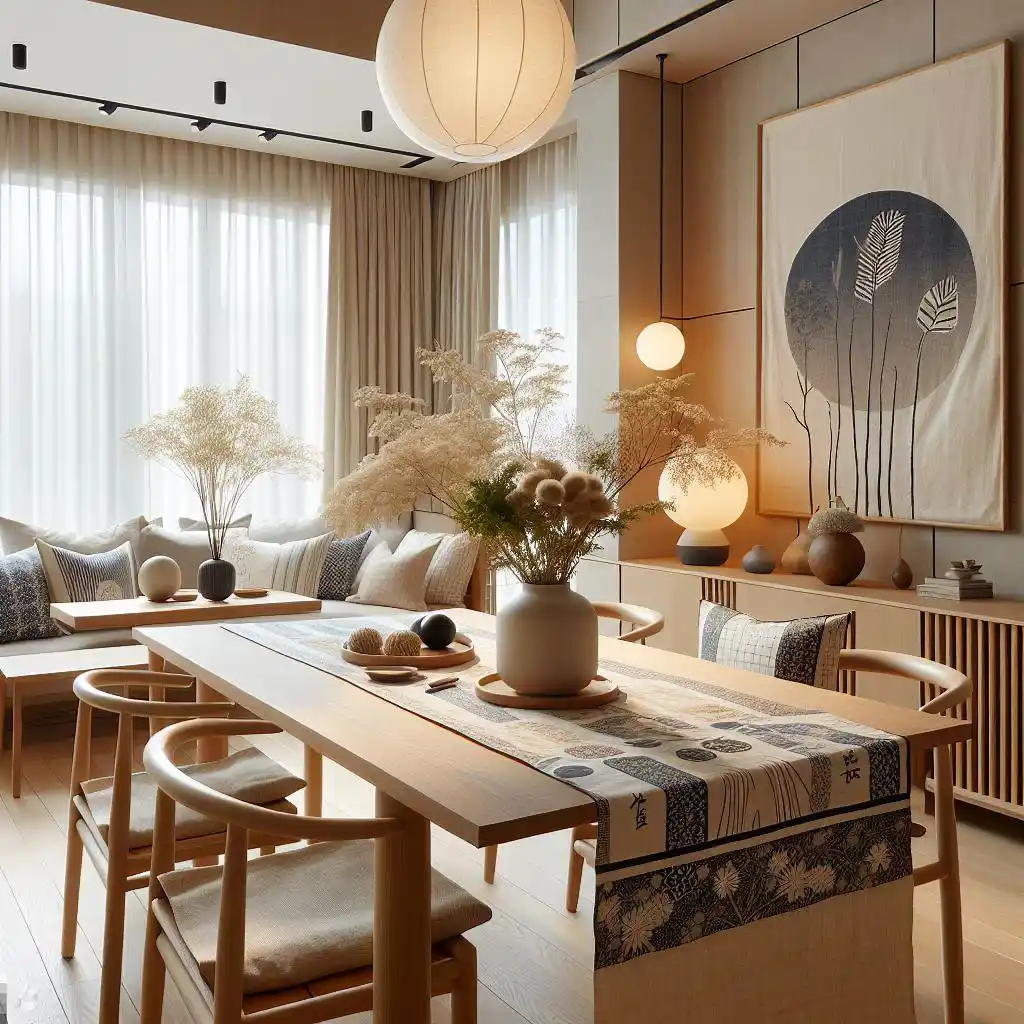
37. Marimekko-inspired Textiles
Integrate Marimekko-inspired textiles with bold patterns and colors, infusing a bit of Finnish design flair into the Japandi mix.
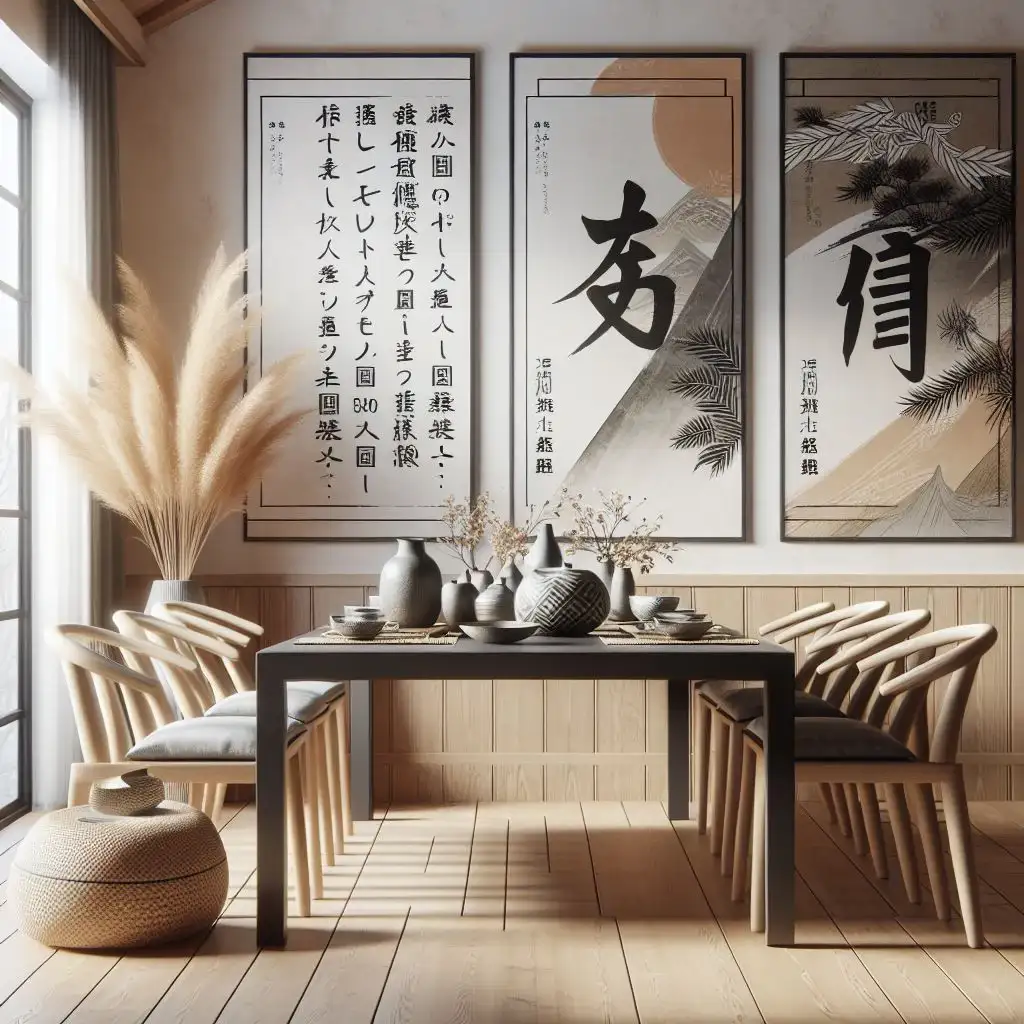
38. Japandi Poetry Wall Art
Display wall art showcasing a blend of Japanese haiku or calligraphy, and Scandinavian typography for a harmonious cultural fusion.
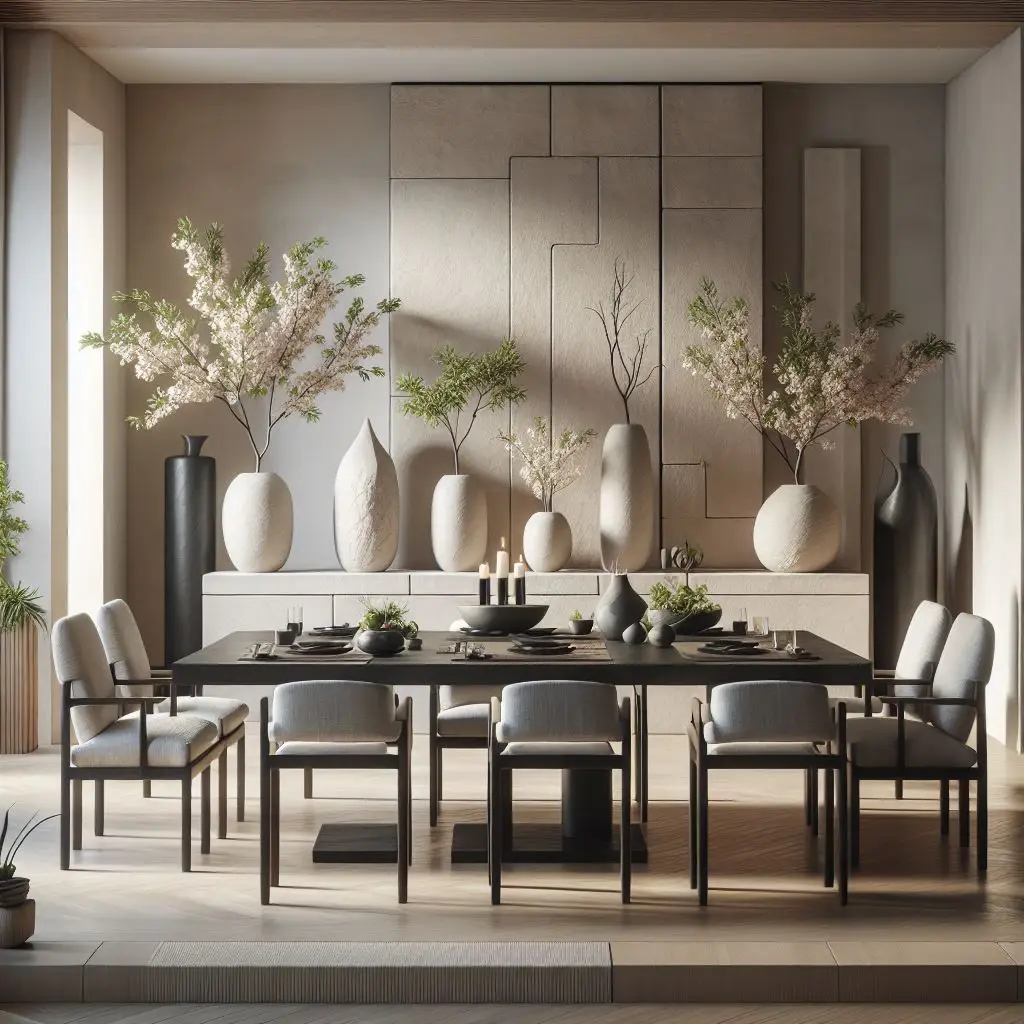
39. Monolithic Stone Vases
Showcase monolithic stone vases with minimalist floral arrangements, bringing a touch of Japanese ikebana aesthetics into the Scandinavian space.
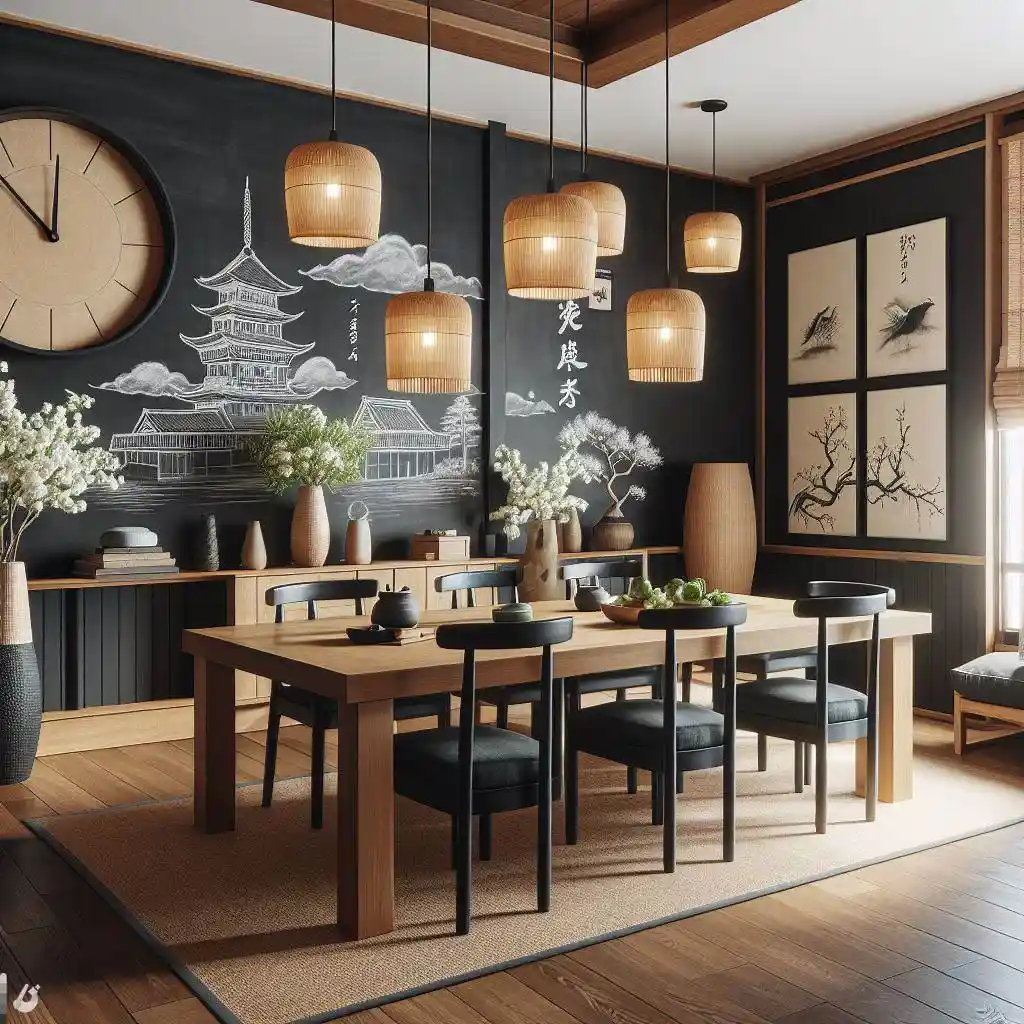
40. Japandi Chalkboard Wall
Create a chalkboard accent wall for artistic expression, combining the functionality of Scandinavian design with the creative spirit of Japanese calligraphy.
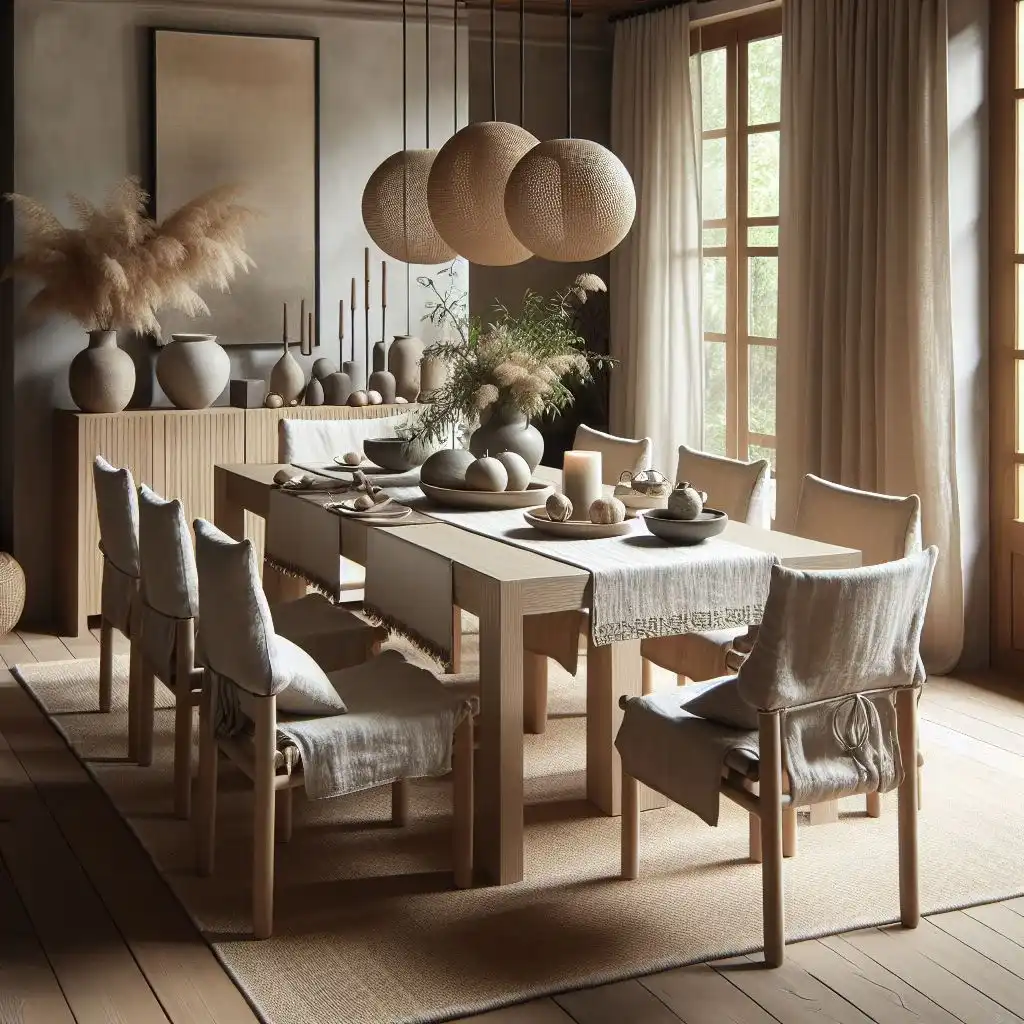
41. Linen Slipcovers
Adorn dining chairs with linen slipcovers in muted tones embody the relaxed elegance of Japanese and Scandinavian interiors.
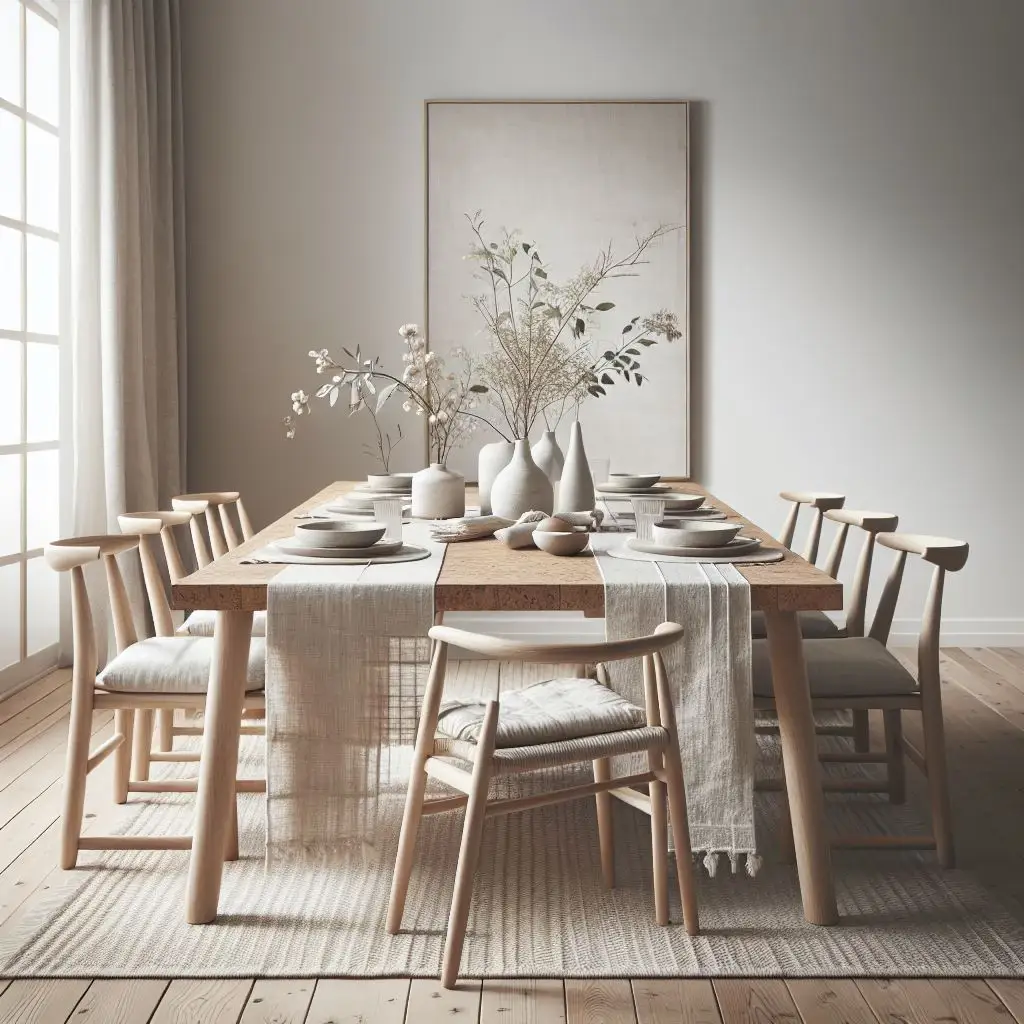
42. Cork-Top Dining Table
Choose a dining table with a cork top, merging sustainable Scandinavian materials with a touch of Japanese earthiness.
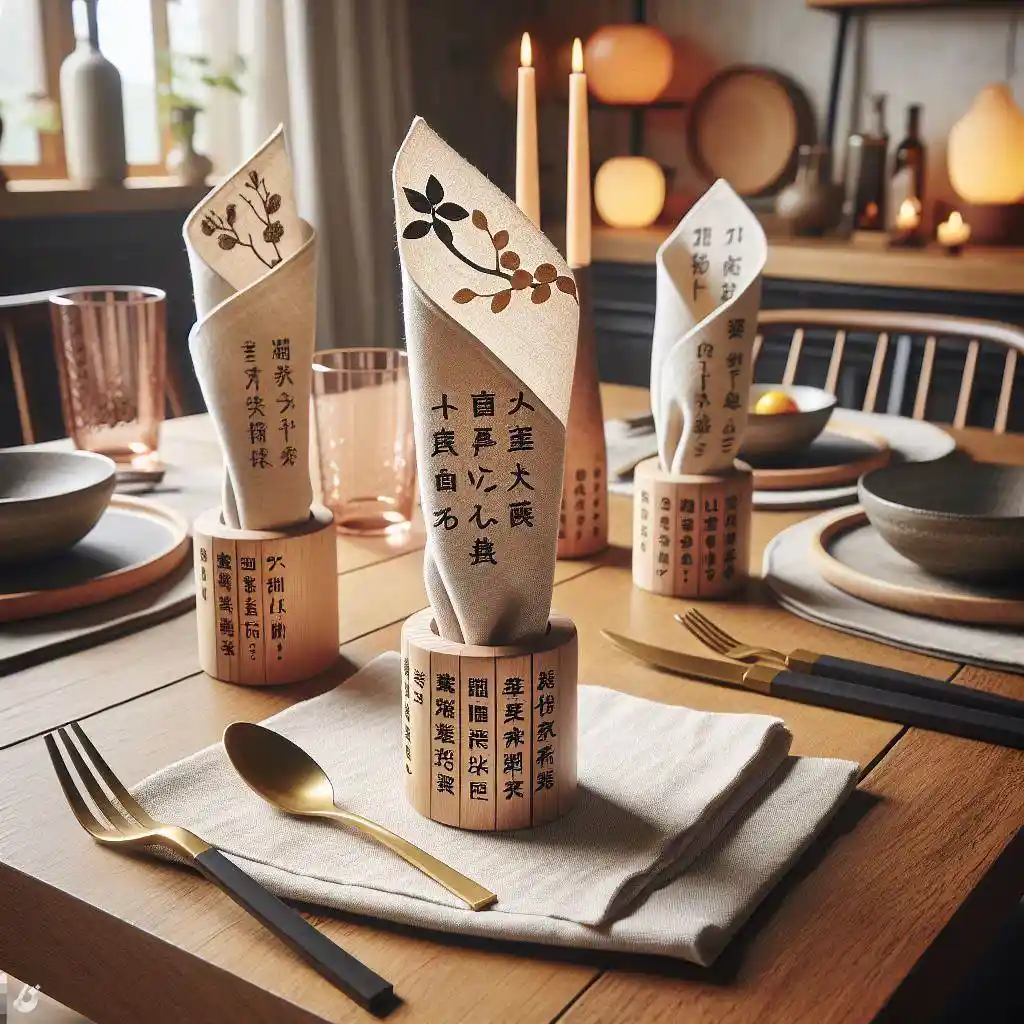
43. Japandi Poetry Napkin Rings
Craft napkin rings with engraved Japanese poetry or Scandinavian sayings, adding a personalized touch to the dining set.
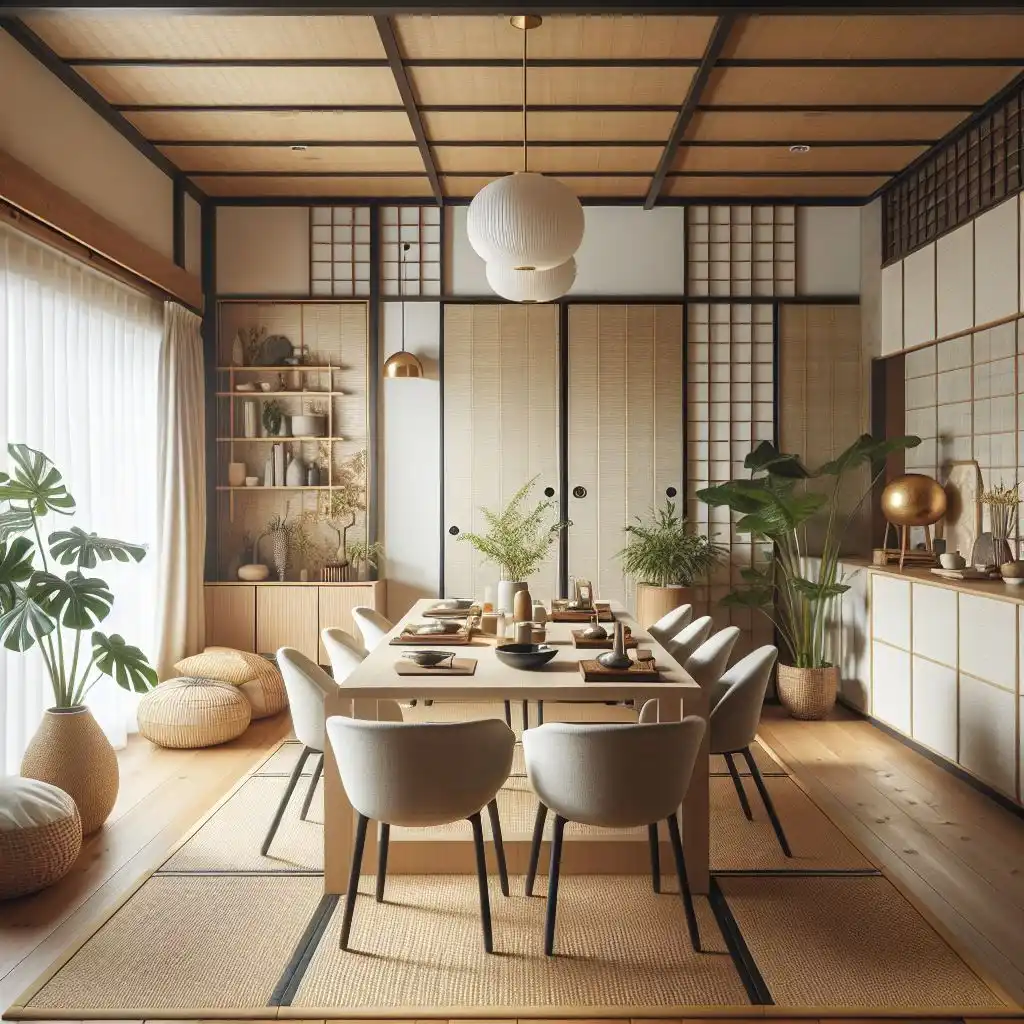
44. Tatami Mat Wall Paneling
Use Tatami mats as wall paneling to infuse the dining room with authentic Japanese aesthetics, paired with Scandinavian furniture.

45. Mid-Century Modern Accents
Integrate Mid-Century Modern elements into the dining space, drawing inspiration from Japanese and Scandinavian design movements.
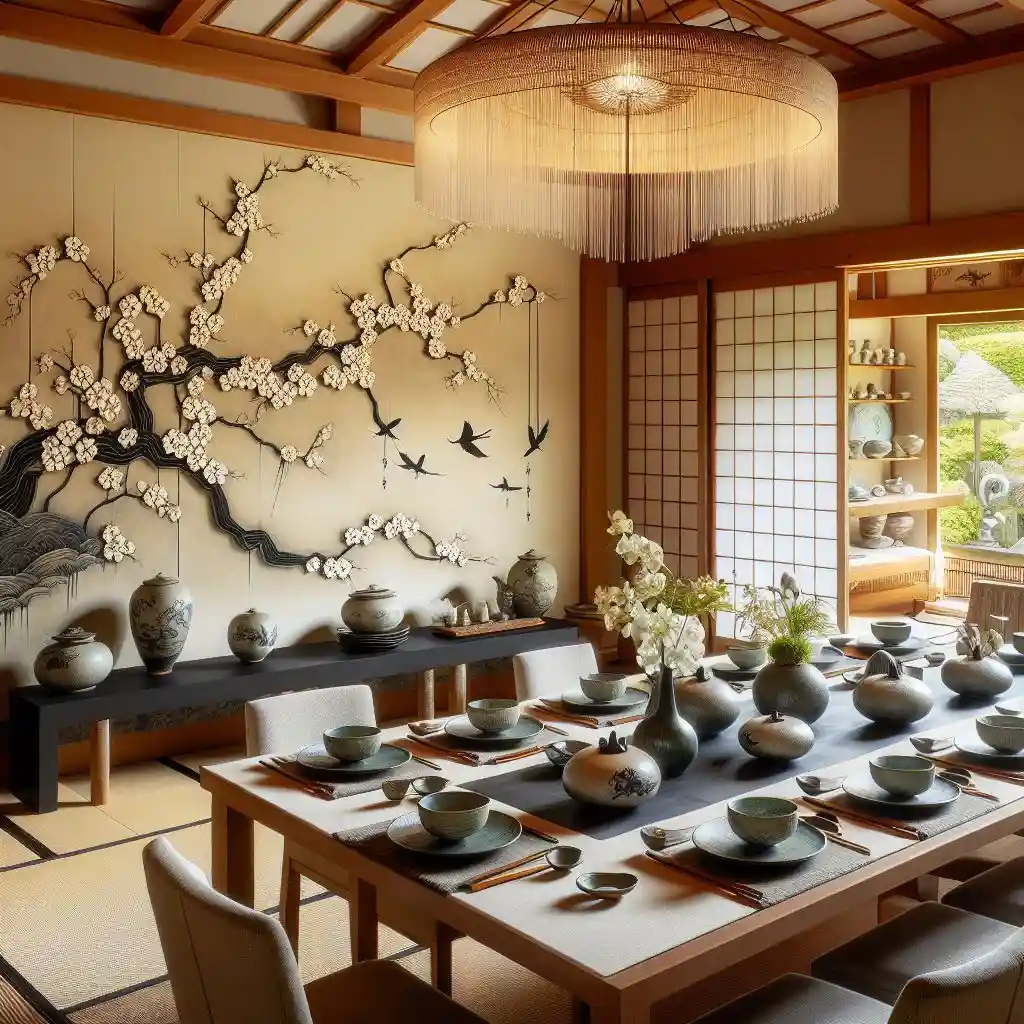
46. Kintsugi Tableware Display
Feature a display of Kintsugi-repaired tableware as an art installation, symbolizing beauty in imperfection from both cultures.

47. Felted Wool Placemats
Lay down felted wool placemats in neutral tones, combining the warmth of Scandinavian textiles with the simplicity of Japanese design.
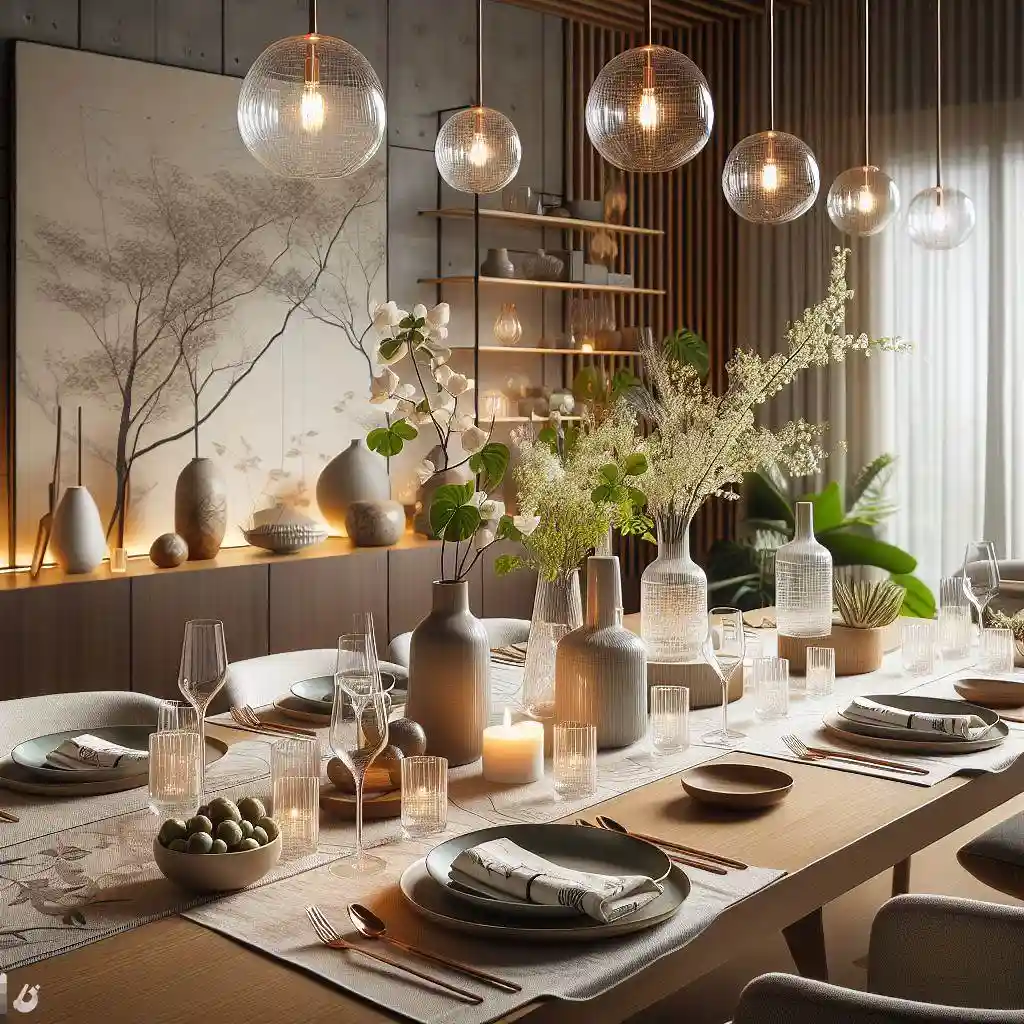
48. Nordic Japandi Glassware
Opt for glassware with clean lines and Nordic-inspired patterns, merging the functional elegance of both cultures.
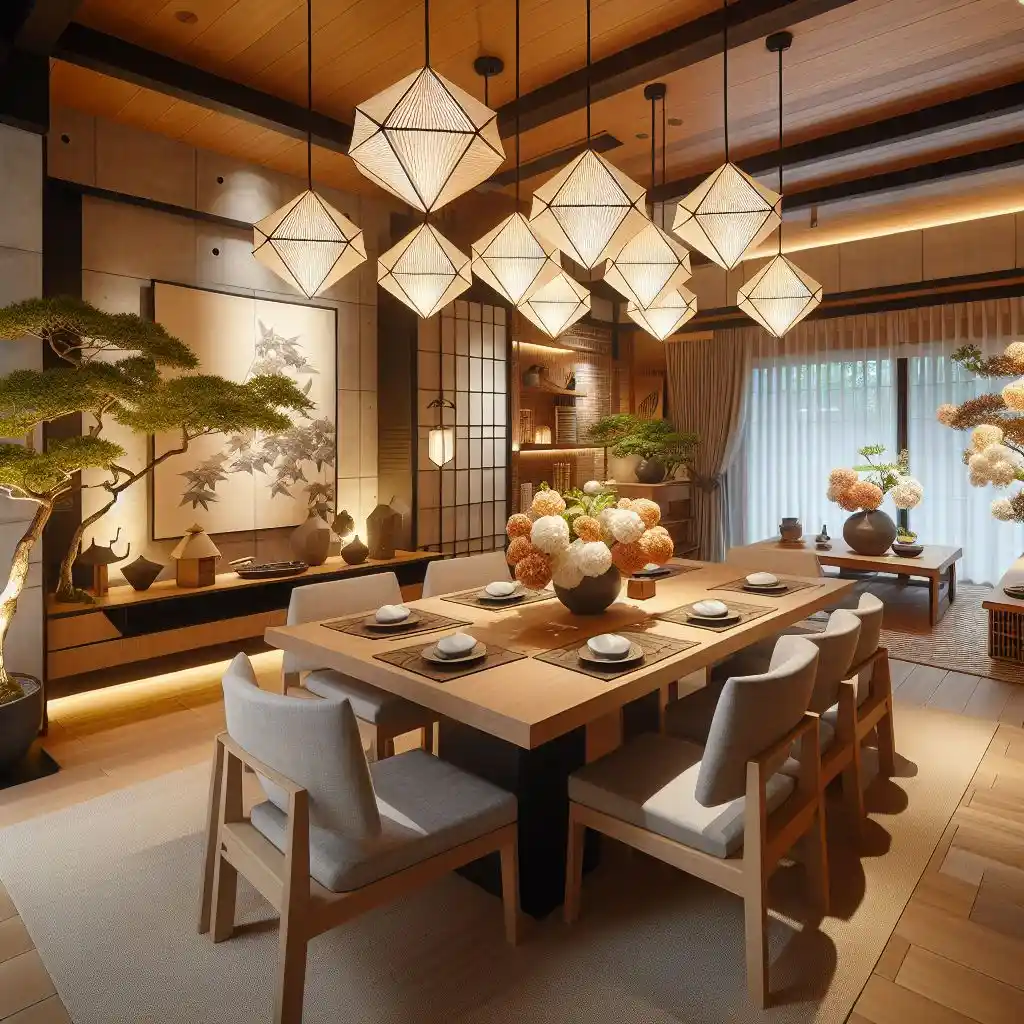
49. Origami Pendant Lights
Hang pendant lights with origami-inspired shades for a delicate and artistic touch, blending Japanese paper craft with Scandinavian lighting design.
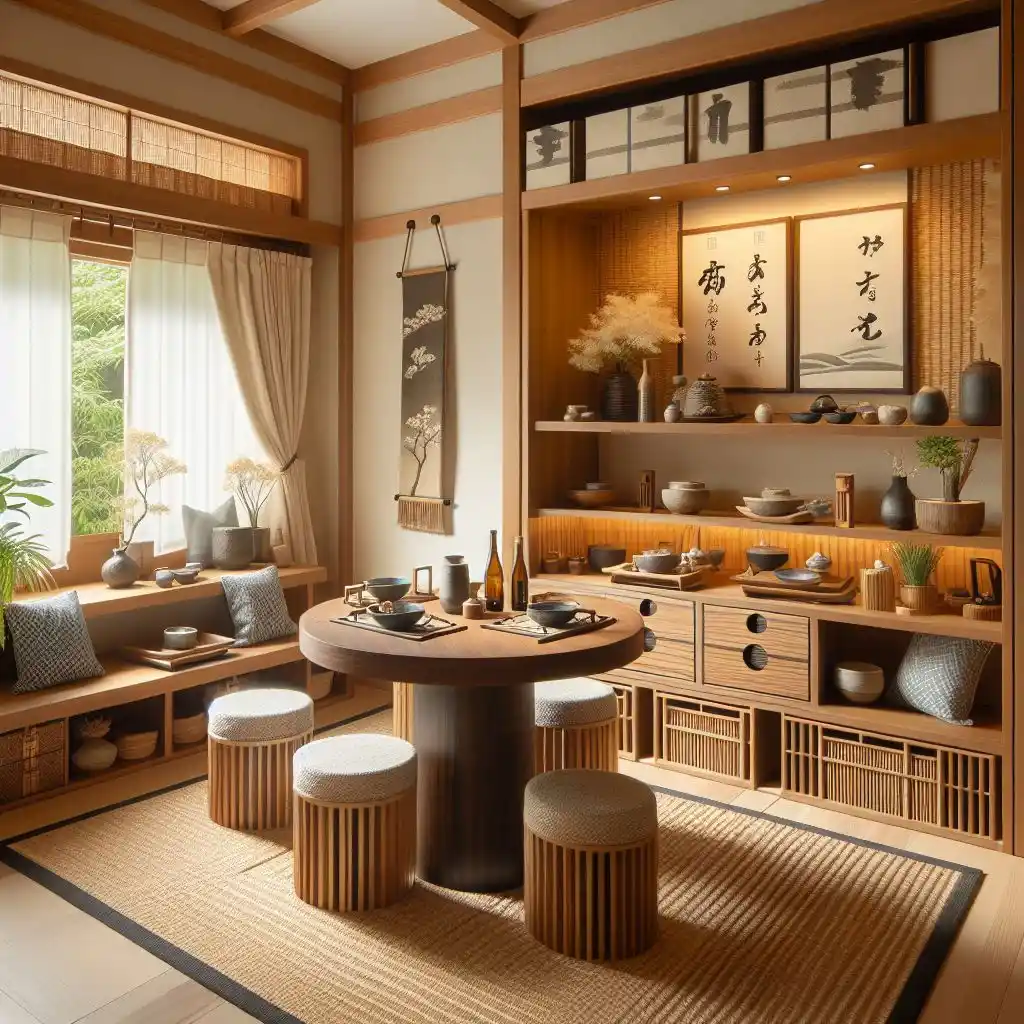
50. Sake Tasting Corner
Create a small corner for sake tasting, featuring a selection of Japanese and Scandinavian-inspired appetizers and drinks.
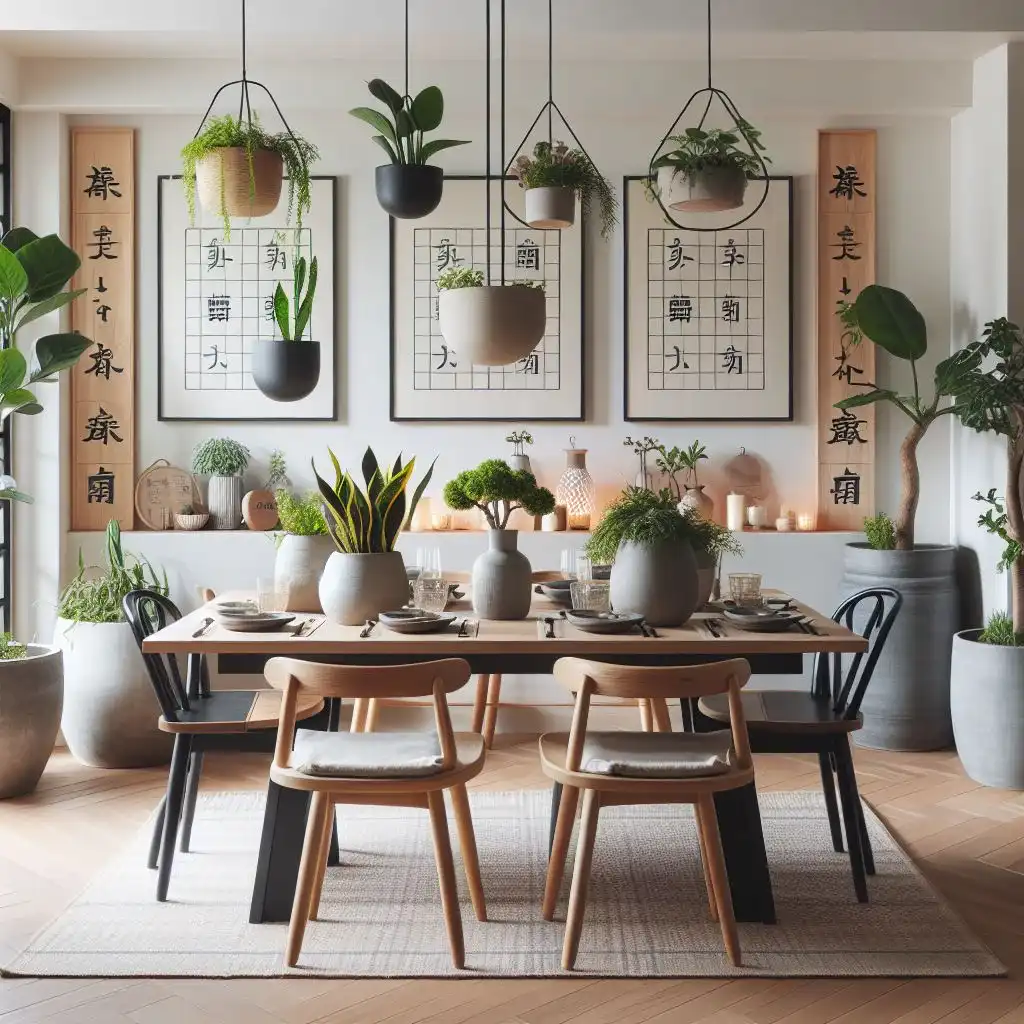
51. Japandi Herb Garden
Set up a small herb garden in the dining area, using Scandinavian-style planters with Japanese-inspired wooden labels for a culinary touch.

